G. P. W. Collection. Plate XLIII
Citrus medica var. limonum.
ROUGH-SKIN LEMON.
This variety is very hardy, bears profusely, and requires much more water than does the orange. Being a strong, vigorous grower, it forms an excellent stock upon which to graft the citrus varieties. The flower is white, with a reddish tint outside. The fruit is generally oval, and contains many seeds. The pale yellow skin is rough and warty. The pulp is coarse-grained and very juicy. It comes true to seed.[Pg 91]
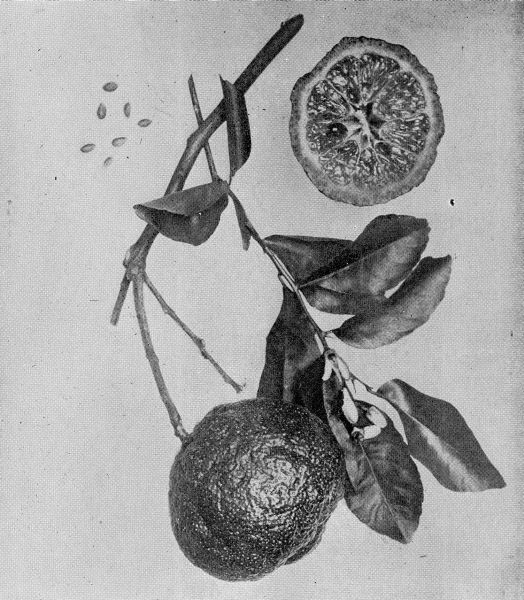
Plate XLIII.—Rough-skin Lemon.
One half natural size.
One half natural size.
[Pg 92]
Citrus Aurantium Sinense.
This tree, which grows to a height of from 20 to 35 feet, is cultivated in all tropical and sub-tropical countries. Its young branches are pale green, angular and glabrous. The leaves are oblong, ovate and pointed, and the petioles are narrowly winged. Its flowers are white and very fragrant. This variety of orange, locally known as the Waialua orange, has a bright yellow fruit, generally round, with a coarse, thick skin, very juicy pulp, and numerous seeds; and was introduced by Vancouver and planted in Hanalei valley, Kauai. It is now widely disseminated throughout the group, and in Kona, Hawaii, grows exceptionally well. This orange is said to produce true to seed.
[Pg 93]
G. P. W. Collection. Plate XLIV
Citrus Aurantium Sinense.
WAIALUA ORANGE.
This tree, which grows to a height of from 20 to 35 feet, is cultivated in all tropical and sub-tropical countries. Its young branches are pale green, angular and glabrous. The leaves are oblong, ovate and pointed, and the petioles are narrowly winged. Its flowers are white and very fragrant. This variety of orange, locally known as the Waialua orange, has a bright yellow fruit, generally round, with a coarse, thick skin, very juicy pulp, and numerous seeds; and was introduced by Vancouver and planted in Hanalei valley, Kauai. It is now widely disseminated throughout the group, and in Kona, Hawaii, grows exceptionally well. This orange is said to produce true to seed.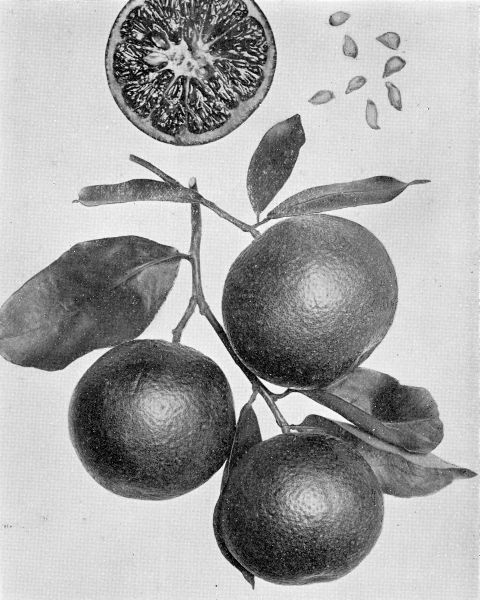
Plate XLIV.—Waialua Orange.
One half natural size.
One half natural size.
[Pg 94]
Citrus Aurantium.
This variety was first introduced into the United States from Brazil, and is now the most popular of all the oranges. It is cultivated extensively in California, in which State the first trees of its kind were planted; for this reason it is often called the Riverside Navel. The fruit is large, solid, and heavy. It is seedless, and has a prominent navel mark at the apex. The brilliant orange color of the skin is one of its characteristics. Grafted and budded trees of this variety of orange may be found growing in many localities in the Hawaiian Islands, but the fruit is not as fine as it should be, as, with few exceptions, it has a tendency to become very dry and woody.
[Pg 95]
G. P. W. Collection. Plate XLV
Citrus Aurantium.
BAHIA, OR WASHINGTON NAVEL ORANGE.
This variety was first introduced into the United States from Brazil, and is now the most popular of all the oranges. It is cultivated extensively in California, in which State the first trees of its kind were planted; for this reason it is often called the Riverside Navel. The fruit is large, solid, and heavy. It is seedless, and has a prominent navel mark at the apex. The brilliant orange color of the skin is one of its characteristics. Grafted and budded trees of this variety of orange may be found growing in many localities in the Hawaiian Islands, but the fruit is not as fine as it should be, as, with few exceptions, it has a tendency to become very dry and woody.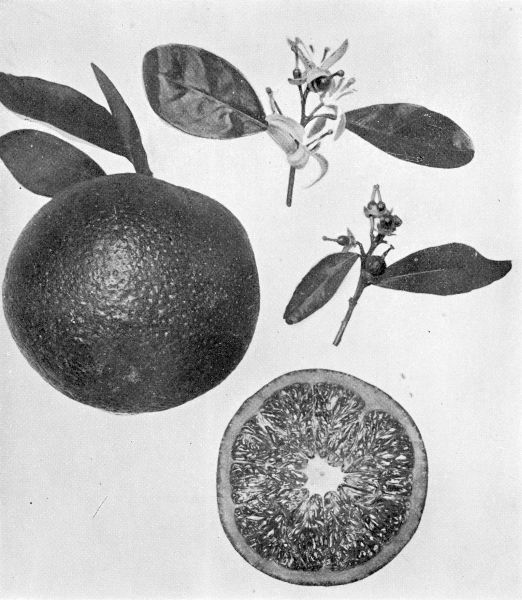
Plate XLV.—Bahia, or Washington Navel Orange.
One half natural size.
One half natural size.
[Pg 96]
Citrus Decumana.
This hardy tree, with its spreading branches, grows to a height of from 15 to 20 feet. It is extensively cultivated in India, and widely distributed over the Malayan and Polynesian Islands. It was early introduced to the Hawaiian Islands, presumably by the Chinese, who seem to be especially fond of the fruit, as it is always an important feature of their New Year's decorations. The leaves are large, oval or ovate-oblong, obtuse, and frequently emarginate, and the petiole is broadly winged. The flowers are large and white. This pyriform variety, which is from 6 to 8 inches in diameter, often weighs 4 to 8 pounds.
The pale-yellow rind is smooth, thick and very bitter, but can be made into a preserve. The pulp varies in color from pale yellow to red, and has a sub-acid, slightly bitter, flavor.
[Pg 97]
G. P. W. Collection. Plate XLVI
Citrus Decumana.
POMELO OR SHADDOCK (pear-shaped var.).
This hardy tree, with its spreading branches, grows to a height of from 15 to 20 feet. It is extensively cultivated in India, and widely distributed over the Malayan and Polynesian Islands. It was early introduced to the Hawaiian Islands, presumably by the Chinese, who seem to be especially fond of the fruit, as it is always an important feature of their New Year's decorations. The leaves are large, oval or ovate-oblong, obtuse, and frequently emarginate, and the petiole is broadly winged. The flowers are large and white. This pyriform variety, which is from 6 to 8 inches in diameter, often weighs 4 to 8 pounds.The pale-yellow rind is smooth, thick and very bitter, but can be made into a preserve. The pulp varies in color from pale yellow to red, and has a sub-acid, slightly bitter, flavor.
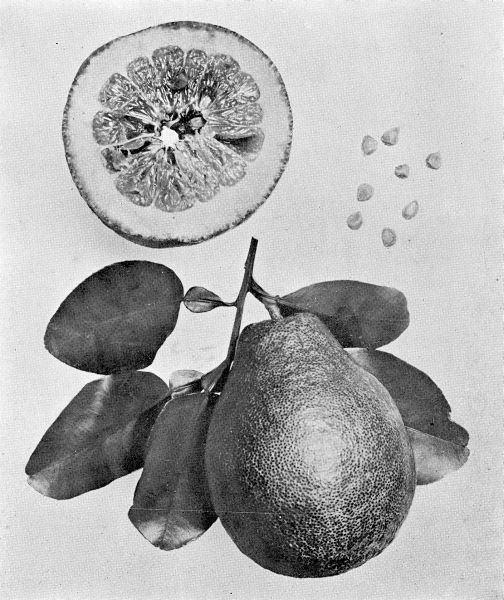
Plate XLVI.—Pomelo or Shaddock (pear-shaped var.)
One third natural size.
One third natural size.
[Pg 98]
Citrus Decumana.
The fruit of this round variety is smaller than that of the preceding variety. The light-yellow rind is coarse, spongy, thick, and leathery. The cells of the pulp are coarse, dry, and have a bitter, sub-acid flavor. There are many large, wedge-shaped seeds.
[Pg 99]
G. P. W. Collection. Plate XLVII
Citrus Decumana.
POMELO OR SHADDOCK (round var.)
The fruit of this round variety is smaller than that of the preceding variety. The light-yellow rind is coarse, spongy, thick, and leathery. The cells of the pulp are coarse, dry, and have a bitter, sub-acid flavor. There are many large, wedge-shaped seeds.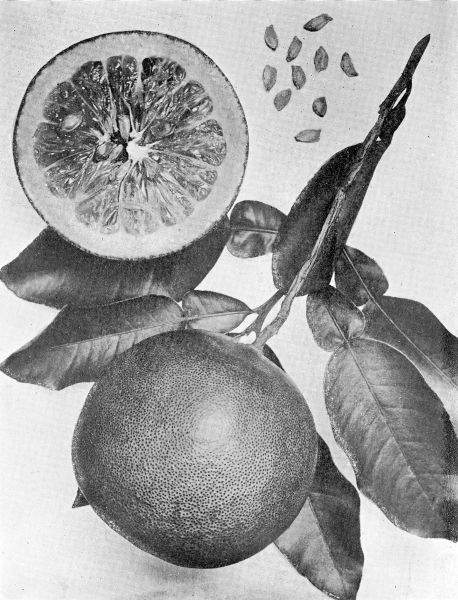
Plate XLVII.—Pomelo or Shaddock (round var.)
One third natural size.
One third natural size.
[Pg 100]
Artocarpus incisa.
The first breadfruit trees were brought from Tahiti by the Hawaiians who, landing at Ewa, carried them across the mountain, and presented them to one of the Chiefs of Oahu, who lived at Kualoa. There they were planted and thrived. At the present day this variety of the breadfruit, now called the Hawaiian variety, is to be found growing wild throughout the Islands. There are many varieties of this handsome tree, which grows to a height of from 15 to 40 feet. It thrives best in hot, moist places, and requires a great deal of water.
Its large ovate leaves are rough and deeply lobed. The male flower is a large yellow catkin. The fruit is formed from the female flowers, and is attached to the branches by large stems. In shape it is either round or oblong, varying in size from 5 to 8 inches in diameter. The thick, tough rind is, in some varieties muricated, and in others it is reticulated. In color it is green, changing to brownish when the fruit is ripe. The pulp is firm, mealy, and somewhat fibrous, and as an article of diet is much esteemed. Propagation is by suckers, or by layers from the branches.
[Pg 101]
G. P. W. Collection. Plate XLVIII
Artocarpus incisa.
BREADFRUIT (Hawaiian var.)
"ULU."
The first breadfruit trees were brought from Tahiti by the Hawaiians who, landing at Ewa, carried them across the mountain, and presented them to one of the Chiefs of Oahu, who lived at Kualoa. There they were planted and thrived. At the present day this variety of the breadfruit, now called the Hawaiian variety, is to be found growing wild throughout the Islands. There are many varieties of this handsome tree, which grows to a height of from 15 to 40 feet. It thrives best in hot, moist places, and requires a great deal of water.Its large ovate leaves are rough and deeply lobed. The male flower is a large yellow catkin. The fruit is formed from the female flowers, and is attached to the branches by large stems. In shape it is either round or oblong, varying in size from 5 to 8 inches in diameter. The thick, tough rind is, in some varieties muricated, and in others it is reticulated. In color it is green, changing to brownish when the fruit is ripe. The pulp is firm, mealy, and somewhat fibrous, and as an article of diet is much esteemed. Propagation is by suckers, or by layers from the branches.
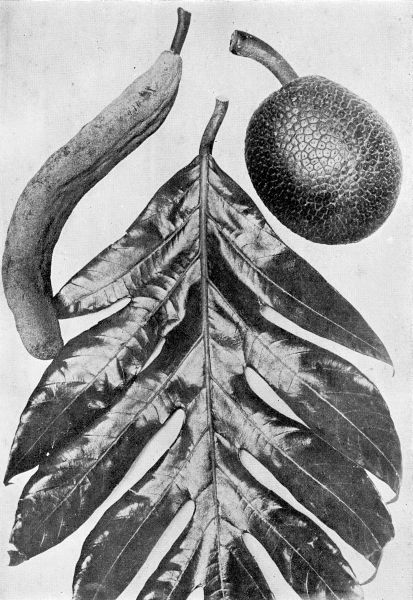
Plate XLVIII.—Breadfruit (Hawaiian var.)—"Ulu."
One third natural size.
One third natural size.
[Pg 102]
Artocarpus incisa.
This variety was introduced to these Islands by Mr. James Bicknell. Its large, oval leaves are leathery and rough, and less deeply lobed than are those of the Hawaiian variety. The round fruit has a characteristic raised ring where it is attached to the long stem. The yellowish-green rind is reticulated, and the orange-colored pulp is somewhat sticky when cooked, and is very sweet. This variety occasionally produces seed.
[Pg 103]
G. P. W. Collection. Plate XLIX
Artocarpus incisa.
BREADFRUIT (Samoan var.)
This variety was introduced to these Islands by Mr. James Bicknell. Its large, oval leaves are leathery and rough, and less deeply lobed than are those of the Hawaiian variety. The round fruit has a characteristic raised ring where it is attached to the long stem. The yellowish-green rind is reticulated, and the orange-colored pulp is somewhat sticky when cooked, and is very sweet. This variety occasionally produces seed.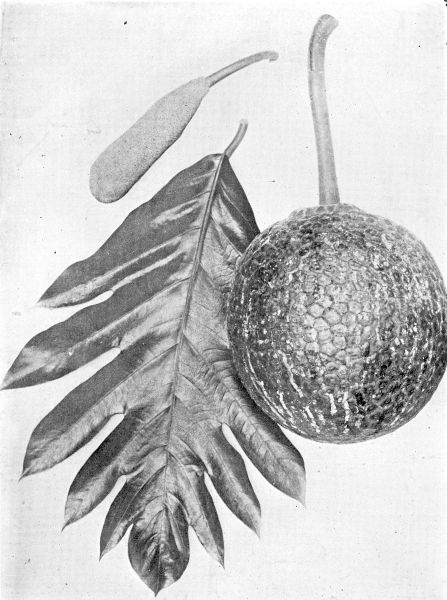
Plate XLIX.—Breadfruit (Samoan var.) One half natural size.
[Pg 104]
Artocarpus incisa.
This variety of Tahitian breadfruit is found only in a few gardens in Hawaii. Its glossy green leaves are nearly entire. The oblong fruit has a deep yellow pulp, with very little fibre.
[Pg 105]
G. P. W. Collection. Plate L
Artocarpus incisa.
BREADFRUIT (Tahitian var.)
This variety of Tahitian breadfruit is found only in a few gardens in Hawaii. Its glossy green leaves are nearly entire. The oblong fruit has a deep yellow pulp, with very little fibre.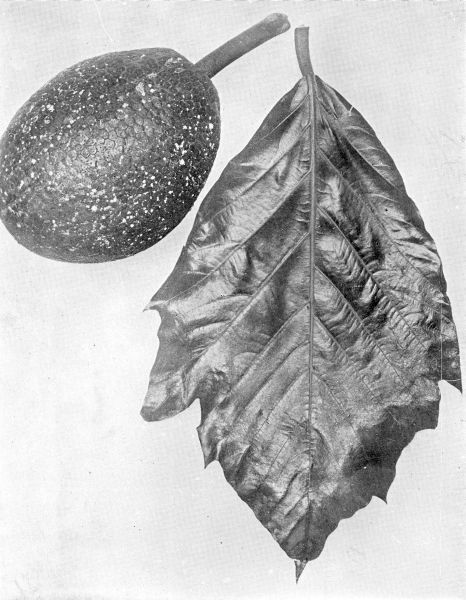
Plate L.—Breadfruit (Tahitian var.)
One half natural size.
One half natural size.
[Pg 106]
Artocarpus incisa.
This seeding variety is rarely cultivated on account of its inferior fruit. The leaves are slightly lobed. The fruit is oblong with a short, thick stem, and is covered with short, hard projections. The fibrous pulp contains numerous large seeds, which are edible when cooked.
[Pg 107]
G. P. W. Collection. Plate LI
Artocarpus incisa.
FERTILE BREADFRUIT.
This seeding variety is rarely cultivated on account of its inferior fruit. The leaves are slightly lobed. The fruit is oblong with a short, thick stem, and is covered with short, hard projections. The fibrous pulp contains numerous large seeds, which are edible when cooked.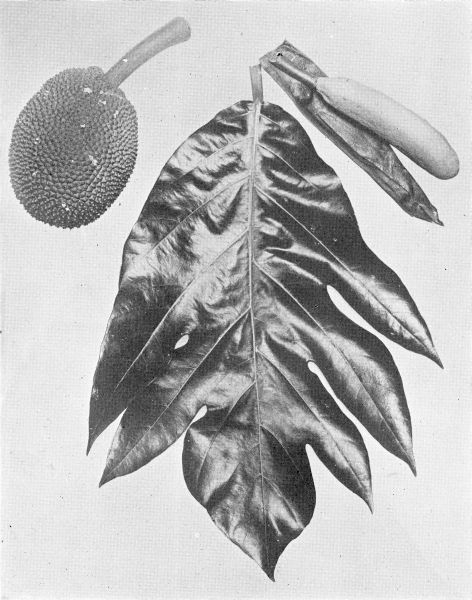
Plate LI.—Fertile Breadfruit.
One third natural size.
One third natural size.
[Pg 108]
Artocarpus integrifolia.
This tree is a native of India and Malay. And was introduced to Hawaii by Mr. David Forbes of Kukuihaele, Hawaii. The Jack fruit is a large, handsome tree, with leaves from 4 to 6 inches in length, which on the old growth are obovate-oblong and on the young branches are narrow. The oblong, irregular fruit, which varies in weight from 20 to 60 pounds, is borne on the trunk, as well as on the old branches. The green rind is covered with small hexagonal knobs. The pulp when ripe has all overpowering odor and is seldom eaten; but the oily seeds when roasted are edible, and are said to resemble chestnuts. On Tantalus, Oahu, the Jack fruit thrives well, and has produced fair sized fruits. It is a tree that needs a great deal of moisture, and consequently is seldom grown on the low lands.
[Pg 109]
G. P. W. Collection. Plate LII
Artocarpus integrifolia.
JACK FRUIT.
This tree is a native of India and Malay. And was introduced to Hawaii by Mr. David Forbes of Kukuihaele, Hawaii. The Jack fruit is a large, handsome tree, with leaves from 4 to 6 inches in length, which on the old growth are obovate-oblong and on the young branches are narrow. The oblong, irregular fruit, which varies in weight from 20 to 60 pounds, is borne on the trunk, as well as on the old branches. The green rind is covered with small hexagonal knobs. The pulp when ripe has all overpowering odor and is seldom eaten; but the oily seeds when roasted are edible, and are said to resemble chestnuts. On Tantalus, Oahu, the Jack fruit thrives well, and has produced fair sized fruits. It is a tree that needs a great deal of moisture, and consequently is seldom grown on the low lands.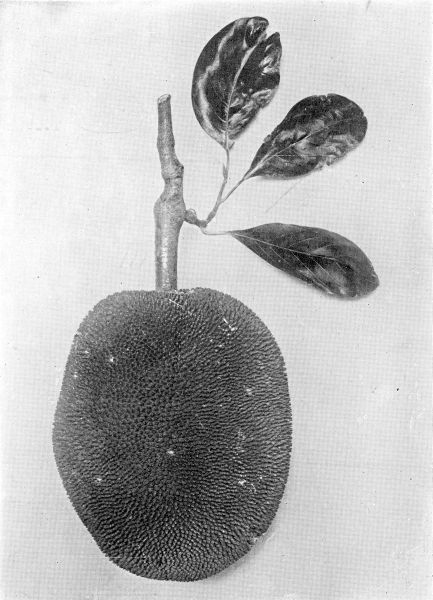
Plate LII.—Jack Fruit.
One fourth natural size.
One fourth natural size.
[Pg 110]
Anona muricata.
This small, hardy evergreen tree is very common in Hawaii. Its dark green, glabrous leaves are pointed, elliptical, and are shiny on the upper surface, but rusty beneath. The greenish-yellow flowers are usually solitary, and have a peculiar odor. The fruit is large, varying in weight from 1 to 15 pounds. In shape, it is either oblong or conical and blunt. The rough, dark green, shiny skin, which is irregular in thickness, is studded with fleshy spines. The soft, white, cotton-like pulp is divided into sections, each containing a shiny, black seed, about half an inch long. These are very readily propagated.
[Pg 111]
G. P. W. Collection. Plate LIII
Anona muricata.
SOUR SOP.
This small, hardy evergreen tree is very common in Hawaii. Its dark green, glabrous leaves are pointed, elliptical, and are shiny on the upper surface, but rusty beneath. The greenish-yellow flowers are usually solitary, and have a peculiar odor. The fruit is large, varying in weight from 1 to 15 pounds. In shape, it is either oblong or conical and blunt. The rough, dark green, shiny skin, which is irregular in thickness, is studded with fleshy spines. The soft, white, cotton-like pulp is divided into sections, each containing a shiny, black seed, about half an inch long. These are very readily propagated.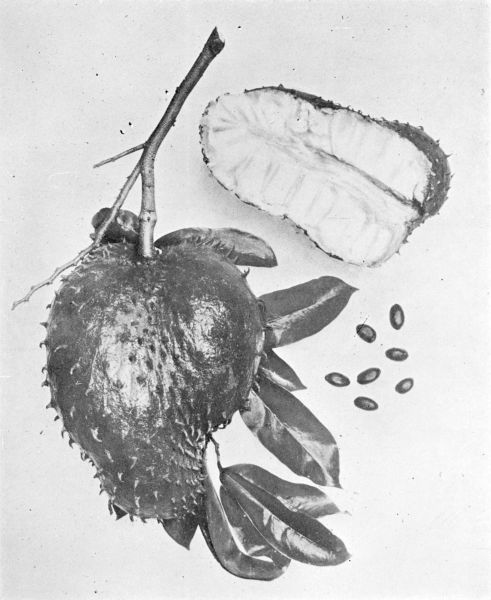
Plate LIII.—Sour Sop.
One third natural size.
One third natural size.
[Pg 112]
Anona Cherimolia.
The Cherimoyer, a well-known fruit of the tropics, is said to be a native of Peru. It is naturalized in Central America, is hardy in the mildest coast regions of Spain, and in Jamaica is cultivated up to an elevation of nearly 5000 feet. It thrives on the Florida Keys, and is also grown to a limited extent in Southern California. The tree grows to a height of from 10 to 20 feet; its branches are spreading, and the dark, shiny leaves are either ovate or oblong, and are sparsely hairy above and velvety beneath.
The single petaled, velvety-green flowers are very fragrant. The fruit, which is about the size of a large orange, is heart-shaped and slightly flattened at the stem end. When ripe, the skin is a greyish-green, and is covered with slightly-raised semicircular markings. The white pulp, which is soft and rich, is divided into cells, each containing a black seed about the size of an ordinary bean. The Cherimoyer comes true to seed and bears in about three years. It is one of the most delicious fruits, and its delicate, slightly-acid flavor is very characteristic. The Cherimoyer was one of the earliest fruits introduced to these Islands, and the best specimens of its kind are grown in Kona and Kau, Hawaii, where it continues to propagate itself naturally from seed.
[Pg 113]
G. P. W. Collection. Plate LIV
Anona Cherimolia.
CHERIMOYER.
The Cherimoyer, a well-known fruit of the tropics, is said to be a native of Peru. It is naturalized in Central America, is hardy in the mildest coast regions of Spain, and in Jamaica is cultivated up to an elevation of nearly 5000 feet. It thrives on the Florida Keys, and is also grown to a limited extent in Southern California. The tree grows to a height of from 10 to 20 feet; its branches are spreading, and the dark, shiny leaves are either ovate or oblong, and are sparsely hairy above and velvety beneath.The single petaled, velvety-green flowers are very fragrant. The fruit, which is about the size of a large orange, is heart-shaped and slightly flattened at the stem end. When ripe, the skin is a greyish-green, and is covered with slightly-raised semicircular markings. The white pulp, which is soft and rich, is divided into cells, each containing a black seed about the size of an ordinary bean. The Cherimoyer comes true to seed and bears in about three years. It is one of the most delicious fruits, and its delicate, slightly-acid flavor is very characteristic. The Cherimoyer was one of the earliest fruits introduced to these Islands, and the best specimens of its kind are grown in Kona and Kau, Hawaii, where it continues to propagate itself naturally from seed.
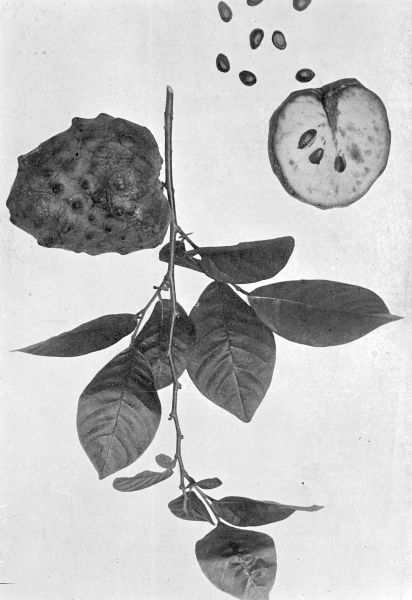
Plate LIV.—Cherimoyer.
One half natural size.
One half natural size.
[Pg 114]
Anona reticulata.
This tree, which is not common in Hawaii, is rather delicate, and grows to a height of from 10 to 15 feet. It is a native of the Antilles, and is a very popular tree in the West Indies. It thrives in Southern California. Its leaves, which are either lanceolate or oblong and pointed, are glabrous above and rough beneath. In color they are light green and rather brittle, when bruised they emit a very unpleasant odor.
The flowers are three-petaled and are greenish or yellowish, with purple spots at the base. Artificial pollination will induce the flowers to set and produce better crops. The heart-shaped fruit is from 3 to 5 inches in diameter. The skin is smooth, with small depressions; when ripe, it is a pinkish-yellow and shading to a russet. Next to the skin the pulp is soft and creamy-yellow, while toward the center it is quite white. The flavor is sweet and delicious. There are numerous smooth, black seeds. This fruit, like its cousin the Cherimoyer grows true to seed.
[Pg 115]
G. P. W. Collection. Plate LV
Anona reticulata.
CUSTARD APPLE.
This tree, which is not common in Hawaii, is rather delicate, and grows to a height of from 10 to 15 feet. It is a native of the Antilles, and is a very popular tree in the West Indies. It thrives in Southern California. Its leaves, which are either lanceolate or oblong and pointed, are glabrous above and rough beneath. In color they are light green and rather brittle, when bruised they emit a very unpleasant odor.The flowers are three-petaled and are greenish or yellowish, with purple spots at the base. Artificial pollination will induce the flowers to set and produce better crops. The heart-shaped fruit is from 3 to 5 inches in diameter. The skin is smooth, with small depressions; when ripe, it is a pinkish-yellow and shading to a russet. Next to the skin the pulp is soft and creamy-yellow, while toward the center it is quite white. The flavor is sweet and delicious. There are numerous smooth, black seeds. This fruit, like its cousin the Cherimoyer grows true to seed.
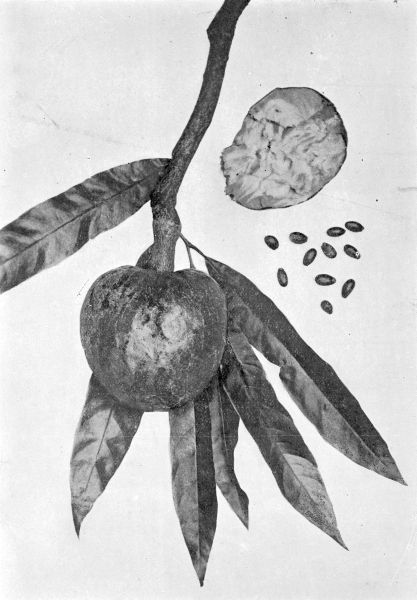
Plate LV.—Custard Apple.
One third natural size.
One third natural size.
[Pg 116]
Anona squamosa.
This small tree is native of the West Indies, from which country the plants found growing in many of our gardens in these Islands were imported. The thin leaves are ovate-oblong, and are very slightly hairy on both sides. The greenish flowers are about an inch long. The fruit which is from 3 to 4 inches in diameter, is the shape of a pine cone; it is greenish-yellow when ripe, and each carpel forms a slight protuberance. The sweet, creamy-white pulp is very delicious. There are numerous small smooth, brownish-black seeds, which germinate readily, and the plants bear fruit in from two to four years. This variety of anona is sensitive to drought, and thrives well at the high elevations.
[Pg 117]
G. P. W. Collection. Plate LVI
Anona squamosa.
SUGAR APPLE—SWEET SOP.
This small tree is native of the West Indies, from which country the plants found growing in many of our gardens in these Islands were imported. The thin leaves are ovate-oblong, and are very slightly hairy on both sides. The greenish flowers are about an inch long. The fruit which is from 3 to 4 inches in diameter, is the shape of a pine cone; it is greenish-yellow when ripe, and each carpel forms a slight protuberance. The sweet, creamy-white pulp is very delicious. There are numerous small smooth, brownish-black seeds, which germinate readily, and the plants bear fruit in from two to four years. This variety of anona is sensitive to drought, and thrives well at the high elevations.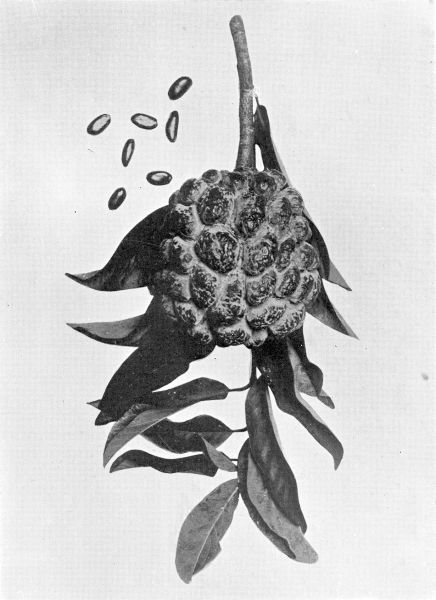
Plate LVI.—Sugar Apple—Sweet Sop.
One half natural size.
One half natural size.
[Pg 118]
Psidium Guayava pomiferum.
The Guava is an extensive genus of low-growing evergreen trees, found chiefly in the West Indies, South America, and China. They have become naturalized in Hawaii, and may be found growing wild on waste lands and by the roadside. In some localities growing so rank as to become troublesome. The leaves are oval to oblong, usually acuminate, glabrous above and pubescent beneath, and have prominent veins. The fragrant, white, solitary flowers are axillary.
The somewhat rough skin of the globose fruit is a brownish-yellow, and the firm, dark-pink pulp, in which is embedded numerous seeds, is generally acid and aromatic. This guava is the source of the famous guava jelly of commerce.
[Pg 119]
G. P. W. Collection. Plate LVII
Psidium Guayava pomiferum.
(Common guava.)
The Guava is an extensive genus of low-growing evergreen trees, found chiefly in the West Indies, South America, and China. They have become naturalized in Hawaii, and may be found growing wild on waste lands and by the roadside. In some localities growing so rank as to become troublesome. The leaves are oval to oblong, usually acuminate, glabrous above and pubescent beneath, and have prominent veins. The fragrant, white, solitary flowers are axillary.The somewhat rough skin of the globose fruit is a brownish-yellow, and the firm, dark-pink pulp, in which is embedded numerous seeds, is generally acid and aromatic. This guava is the source of the famous guava jelly of commerce.
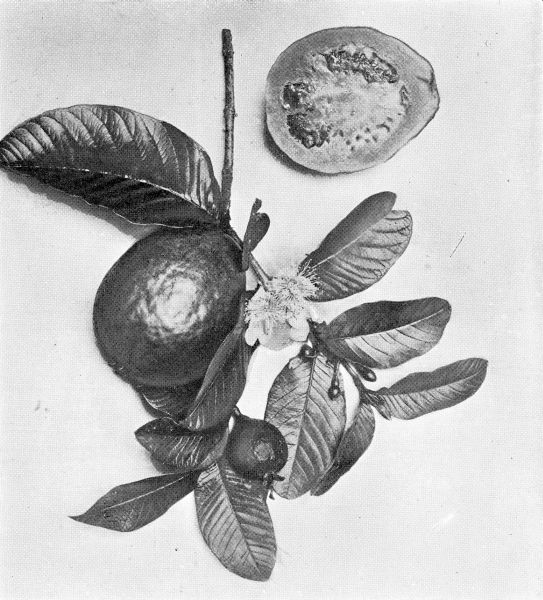
Plate LVII.—Psidium Guayava pomiferum (common guava).
One half natural size.
One half natural size.
[Pg 120]
Psidium Guayava.
This guava has the same general characteristics as the preceding variety. It is more frequently found in valleys and gulches than in the open. Its red pulp is firm and sweet.
[Pg 121]
G. P. W. Collection. Plate LVIII
Psidium Guayava.
(Sweet red guava.)
This guava has the same general characteristics as the preceding variety. It is more frequently found in valleys and gulches than in the open. Its red pulp is firm and sweet.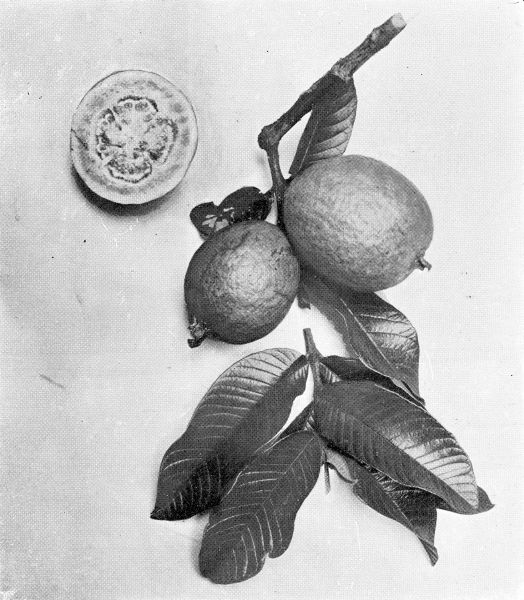
Plate LVIII.—Psidium Guayava (sweet red guava).
[Pg 122]
Psidium Guayava.
The lemon guava tree grows taller and somewhat more erect than the others. The pear-shaped fruit is large, often 3 inches in length. It has a rough, greenish-white skin, and the white pulp is sweet. This is a cultivated variety, and is found growing in a few gardens in these Islands.
[Pg 123]
G. P. W. Collection. Plate LIX
Psidium Guayava.
(White lemon guava.)
The lemon guava tree grows taller and somewhat more erect than the others. The pear-shaped fruit is large, often 3 inches in length. It has a rough, greenish-white skin, and the white pulp is sweet. This is a cultivated variety, and is found growing in a few gardens in these Islands.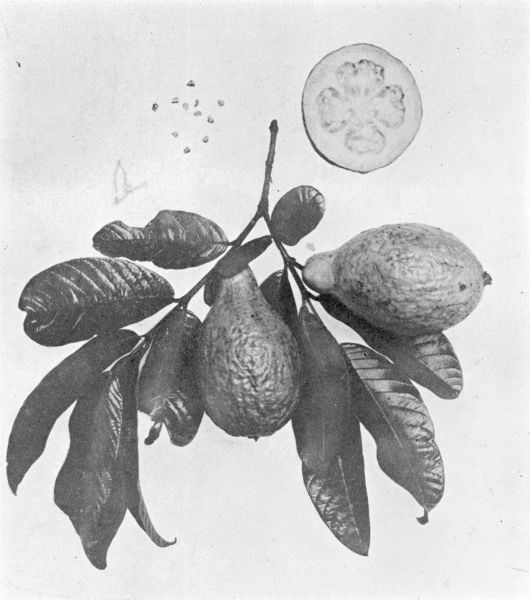
Plate LIX.—Psidium Guayava (white lemon guava).
One half natural size.
One half natural size.
[Pg 124]
Psidium Guayava pyriferum.
This handsome evergreen tree was an early introduced species, and now is very common about the islands. Grows very symmetrically, and attains the height of 20 to 25 feet. Leaves, small, lanceolate, shiny, the trunk and branches smooth. Flowers white and very fragrant; fruit small, pear-shaped, pulp yellow and containing many seeds; this species is very prolific, but the fruit is inferior.
[Pg 125]
G. P. W. Collection. Plate LX
Psidium Guayava pyriferum.
"WAIAWI."
This handsome evergreen tree was an early introduced species, and now is very common about the islands. Grows very symmetrically, and attains the height of 20 to 25 feet. Leaves, small, lanceolate, shiny, the trunk and branches smooth. Flowers white and very fragrant; fruit small, pear-shaped, pulp yellow and containing many seeds; this species is very prolific, but the fruit is inferior.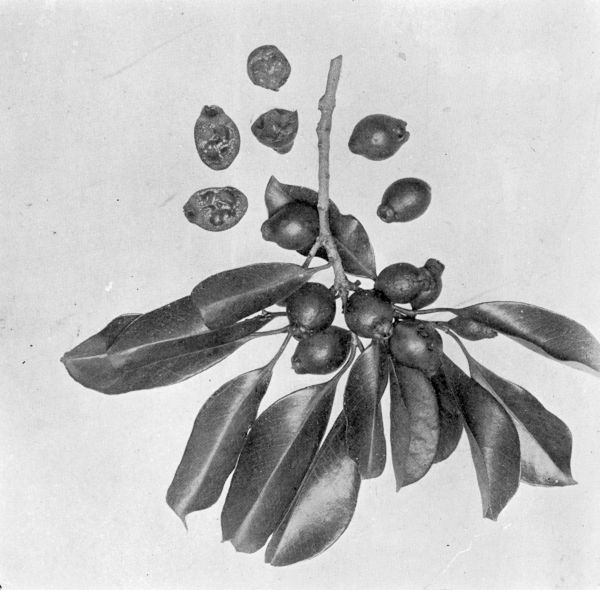
Plate LX.—"Waiawi."
One half natural size.
One half natural size.
[Pg 126]
Psidium Cattleyanum.
One of the hardiest of the guavas, and said to be a native of Brazil. The date of its introduction to Hawaii is not recorded, and as Hillebrand makes no mention of it, it is probably of recent importation. A shrubby tree 15 to 20 feet high. Leaves opposite, obovate, small, leathery, dark-green, shiny. Flowers white, fragrant. Fruit spherical, about one inch in diameter, purple-reddish when ripe, soft, juicy pulp, which has an agreeable flavor, and containing many small seeds. This fruit is used for making jams and jellies, and bears a crop more or less during all the months of the year.
[Pg 127]
G. P. W. Collection. Plate LXI
Psidium Cattleyanum.
STRAWBERRY GUAVA.
One of the hardiest of the guavas, and said to be a native of Brazil. The date of its introduction to Hawaii is not recorded, and as Hillebrand makes no mention of it, it is probably of recent importation. A shrubby tree 15 to 20 feet high. Leaves opposite, obovate, small, leathery, dark-green, shiny. Flowers white, fragrant. Fruit spherical, about one inch in diameter, purple-reddish when ripe, soft, juicy pulp, which has an agreeable flavor, and containing many small seeds. This fruit is used for making jams and jellies, and bears a crop more or less during all the months of the year.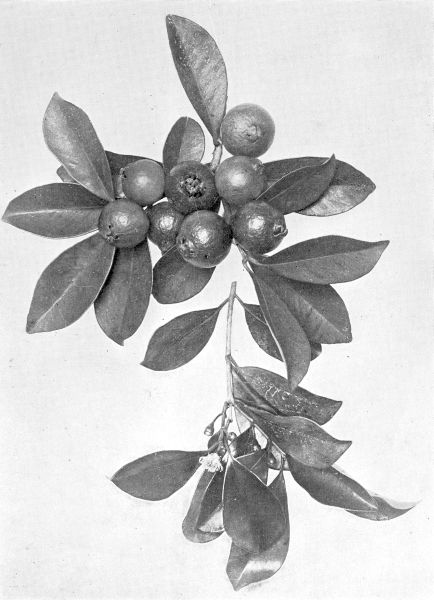
Plate LXI.—Strawberry Guava.
One half natural size.
One half natural size.
[Pg 128]
Psidium Cattleyanum.
This low-growing shrub is occasionally cultivated in these Islands. It has opposite obovate leaves, and fragrant white flowers. The round fruit, which has a sweet, yellow pulp, is larger than the strawberry guava, and has a more delicate flavor.
[Pg 129]
G. P. W. Collection. Plate LXII
Psidium Cattleyanum.
(var. lucidum.)
This low-growing shrub is occasionally cultivated in these Islands. It has opposite obovate leaves, and fragrant white flowers. The round fruit, which has a sweet, yellow pulp, is larger than the strawberry guava, and has a more delicate flavor.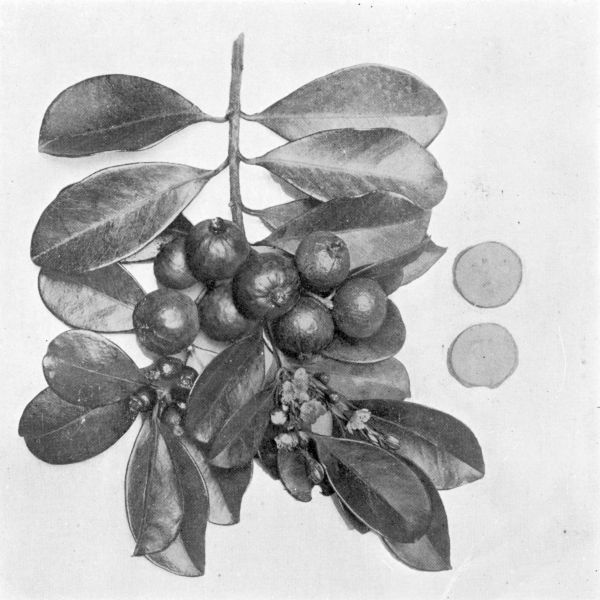
Plate LXII.—Psidium Cattleyanum.
(var. lucidum.)
One half natural size.
(var. lucidum.)
One half natural size.
[Pg 130]
[Pg 131]
G. P. W. Collection. Plate LXIII
Psidium molle.
This species was introduced to Hawaii by Mr. A. Jaeger; and a single specimen of its kind is now growing at the Old Plantation, Honolulu. It is a low-growing, slender, willow-like tree of straggling growth. The opposite leaves are small, stiff and rough. The white flowers are fragrant. The small, round fruit is brownish-green, turning to a pale yellow when ripe. The white pulp is slightly acid, and contains many seeds. This guava is rather an inferior fruit.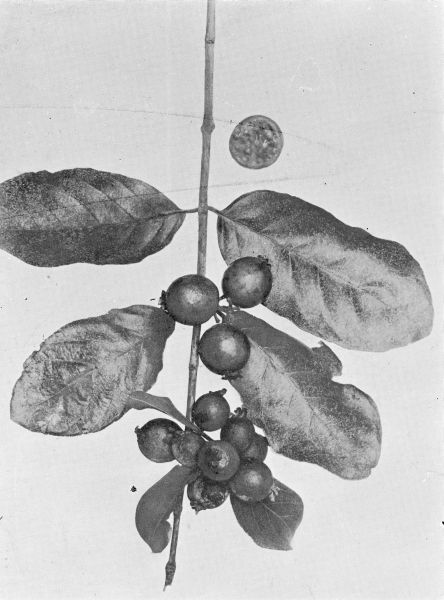
Plate LXIII.—Psidium molle.
One half natural size.
One half natural size.
[Pg 132]
Mangifera indica.
The mango, which is a native of South Asia, is extensively cultivated throughout India, the Islands of the West Indies, and somewhat in Florida. In Hawaii it has become thoroughly naturalized, and is one of the most common trees; growing from the sea level up to about 1,000 feet.
A hot, rather dry, climate, with well-drained soil suits it best. It is an evergreen, shady tree of quick growing habit, sometimes reaching a height of 70 feet, and having a round, dense top. All parts of the mango tree have a resinous fragrance, that suggests turpentine. Its thick, shiny leaves are from 6 to 10 inches in length. The greenish, scented flowers are borne in large terminal panicles; and these are followed three or four months later by the fruit, which is large and kidney-shaped, having a smooth, rather soft, pale-green skin, with tints of yellow and red. The large seed is nearly as long as the fruit, its shell is rough and fibrous, and the kernel is shaped like a bean. In the inferior varieties of mangoes the pulp is full of fibre and tastes strongly of turpentine. There are numerous varieties of the mango cultivated in Hawaii; the fruit of which varies much in point of flavor, juiciness, as well as in the size and shape of the seed.
Within the past ten years improved varieties have been imported; notably the Alphonse, Cambodiana, Pirie, and many others. These have thrived well and have borne delicious fruit; from them many grafts have been made and the finer grades of mangoes have been disseminated. Propagation is effected by seed, by grafting or inarching, and by budding. The mango as a rule does not come true to seed; also seedlings take much longer to fruit than do the grafted trees.
The illustration on the opposite page is that of the so-called common mango, which was brought to Hawaii from Mexico.
[Pg 133]
G. P. W. Collection. Plate LXIV
Mangifera indica.
MANGO.
The mango, which is a native of South Asia, is extensively cultivated throughout India, the Islands of the West Indies, and somewhat in Florida. In Hawaii it has become thoroughly naturalized, and is one of the most common trees; growing from the sea level up to about 1,000 feet.A hot, rather dry, climate, with well-drained soil suits it best. It is an evergreen, shady tree of quick growing habit, sometimes reaching a height of 70 feet, and having a round, dense top. All parts of the mango tree have a resinous fragrance, that suggests turpentine. Its thick, shiny leaves are from 6 to 10 inches in length. The greenish, scented flowers are borne in large terminal panicles; and these are followed three or four months later by the fruit, which is large and kidney-shaped, having a smooth, rather soft, pale-green skin, with tints of yellow and red. The large seed is nearly as long as the fruit, its shell is rough and fibrous, and the kernel is shaped like a bean. In the inferior varieties of mangoes the pulp is full of fibre and tastes strongly of turpentine. There are numerous varieties of the mango cultivated in Hawaii; the fruit of which varies much in point of flavor, juiciness, as well as in the size and shape of the seed.
Within the past ten years improved varieties have been imported; notably the Alphonse, Cambodiana, Pirie, and many others. These have thrived well and have borne delicious fruit; from them many grafts have been made and the finer grades of mangoes have been disseminated. Propagation is effected by seed, by grafting or inarching, and by budding. The mango as a rule does not come true to seed; also seedlings take much longer to fruit than do the grafted trees.
The illustration on the opposite page is that of the so-called common mango, which was brought to Hawaii from Mexico.
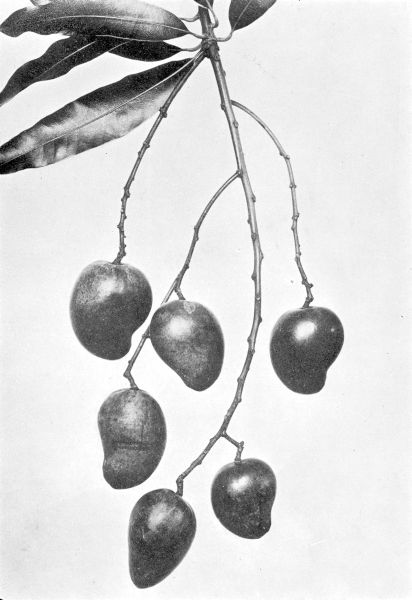
Plate LXIV.—Mango.
One third natural size.
One third natural size.
[Pg 134]
Mangifera indica.
This tree is supposed to be the first mango tree brought to the Hawaiian Islands. It was planted in the early part of the nineteenth century by Don Marin, whom the Hawaiians familiarly called "Manini." He brought to Hawaii many useful trees and plants; among the number was this mango, which he planted in his vineyard, then known as "Ka Pa Waina," and there it may be found today; a venerable tree standing about 80 feet high, having a spread of over 100 feet, and its trunk measuring 15 feet in circumference. Although a prolific bearer, its fruits, which are borne in large clusters, are small, and of an inferior quality, having a thick skin and a large, hairy seed.
[Pg 135]
G. P. W. Collection. Plate LXV
Mangifera indica.
MANINI MANGO.
This tree is supposed to be the first mango tree brought to the Hawaiian Islands. It was planted in the early part of the nineteenth century by Don Marin, whom the Hawaiians familiarly called "Manini." He brought to Hawaii many useful trees and plants; among the number was this mango, which he planted in his vineyard, then known as "Ka Pa Waina," and there it may be found today; a venerable tree standing about 80 feet high, having a spread of over 100 feet, and its trunk measuring 15 feet in circumference. Although a prolific bearer, its fruits, which are borne in large clusters, are small, and of an inferior quality, having a thick skin and a large, hairy seed.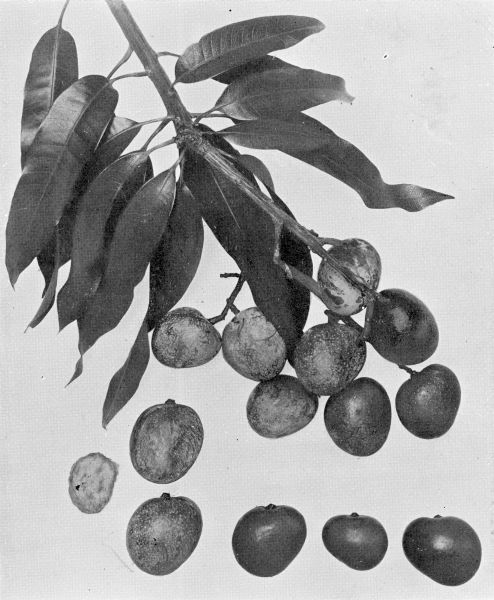
Plate LXV.—Manini Mango.
One half natural size.
One half natural size.
[Pg 136]
Mangifera indica.
This mango, with its distinctive shape, is one of the few types that comes true to seed. The first and original tree, which was planted at the Government Nursery, Honolulu, was brought from Jamaica by Joseph Marsden, Esq. This tree is a prolific bearer, and its seeds have been widely distributed throughout these Islands. The fruit is large and regular in size, having a thick skin which is of a light-green color. The pulp is pale yellow, very juicy, and slightly acid. There is a very large, hairy seed.
[Pg 137]
G. P. W. Collection. Plate LXVI
Mangifera indica.
NO. 9 MANGO.
This mango, with its distinctive shape, is one of the few types that comes true to seed. The first and original tree, which was planted at the Government Nursery, Honolulu, was brought from Jamaica by Joseph Marsden, Esq. This tree is a prolific bearer, and its seeds have been widely distributed throughout these Islands. The fruit is large and regular in size, having a thick skin which is of a light-green color. The pulp is pale yellow, very juicy, and slightly acid. There is a very large, hairy seed.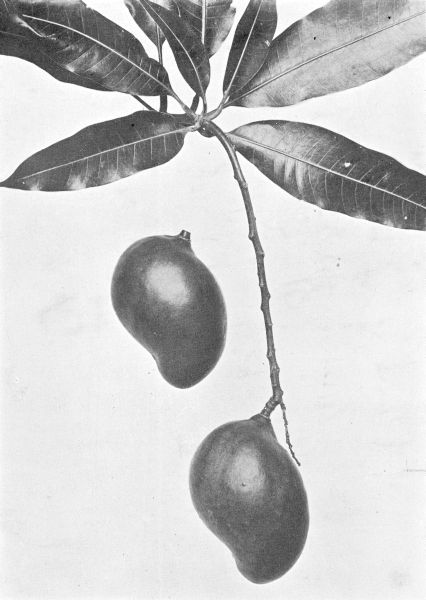
Plate LXVI.—No. 9 Mango.
One half natural size.
One half natural size.
[Pg 138]
Musa varieties.
The banana, which has been cultivated from the most remote times, is a plant of great importance in tropical and sub-tropical climates, where its highly nutritious fruit is used as food. It is a large herbaceous, slightly shrubby, plant of very easy growth, having immense, gracefully-arching, undivided leaves. There are numerous varieties, the fruit of which differs in shape, color and flavor.
As decorative plants in landscape gardening, few subjects equal the choice species of the banana; and on account of its utility, combined with its beauty, it is considered one of the most valuable of tropical products. Propagation is by off-shoots or suckers. When a stalk is cut, the fruit of which has ripened, sprouts are put forth which in time bear fruit. The enormous flower stalk issues from the center of the crown of leaves, and curves over with its own weight.
The flowers are arranged in a dense terminal panicle; they alternate with large, reddish scales, which drop off as the fruit stalk develops, and the finger-like fruits are in clusters. The Hawaiians seem to have possessed the banana from the earliest times, and about fifty varieties were known to the older natives. However, since the year 1855, the so-called Chinese banana (Musa Cavendishii), which was at that time introduced from Tahiti, has crowded out the native varieties, many of which are now extinct.
The accompanying cut shows a few of the different forms and sizes of the banana grown in Hawaii.
[Pg 139]
G. P. W. Collection. Plate LXVII
Musa varieties.
BANANA—"MAIA."
The banana, which has been cultivated from the most remote times, is a plant of great importance in tropical and sub-tropical climates, where its highly nutritious fruit is used as food. It is a large herbaceous, slightly shrubby, plant of very easy growth, having immense, gracefully-arching, undivided leaves. There are numerous varieties, the fruit of which differs in shape, color and flavor.As decorative plants in landscape gardening, few subjects equal the choice species of the banana; and on account of its utility, combined with its beauty, it is considered one of the most valuable of tropical products. Propagation is by off-shoots or suckers. When a stalk is cut, the fruit of which has ripened, sprouts are put forth which in time bear fruit. The enormous flower stalk issues from the center of the crown of leaves, and curves over with its own weight.
The flowers are arranged in a dense terminal panicle; they alternate with large, reddish scales, which drop off as the fruit stalk develops, and the finger-like fruits are in clusters. The Hawaiians seem to have possessed the banana from the earliest times, and about fifty varieties were known to the older natives. However, since the year 1855, the so-called Chinese banana (Musa Cavendishii), which was at that time introduced from Tahiti, has crowded out the native varieties, many of which are now extinct.
The accompanying cut shows a few of the different forms and sizes of the banana grown in Hawaii.
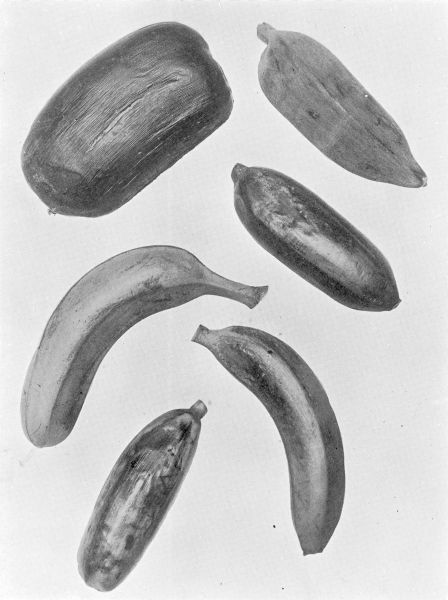
Plate LXVII.—Banana—"Maia."
One half natural size.
One half natural size.
MoaLargo
PopouluRed Cuban
LeleChinese
PopouluRed Cuban
LeleChinese
[Pg 140]
Morinda citrifolia.
This species is found in nearly all the Pacific Islands. The date of its introduction to Hawaii, however, is not recorded. It is a small tree which grows in the low lands. Its shiny, oval leaves have short petioles. The white flowers are about 1 inch in length. The fruit is whitish-yellow when mature, and when decaying it emits a very offensive odor. The seeds are interesting because they will float a great length of time in salt water, their buoyancy is caused by a distinct air cell.
[Pg 141]
G. P. W. Collection. Plate LXVIII
Morinda citrifolia.
"NONI."
This species is found in nearly all the Pacific Islands. The date of its introduction to Hawaii, however, is not recorded. It is a small tree which grows in the low lands. Its shiny, oval leaves have short petioles. The white flowers are about 1 inch in length. The fruit is whitish-yellow when mature, and when decaying it emits a very offensive odor. The seeds are interesting because they will float a great length of time in salt water, their buoyancy is caused by a distinct air cell.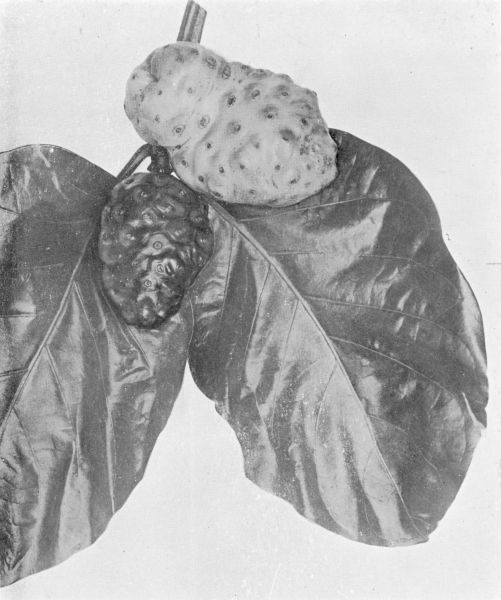
Plate LXVIII.—"Noni."
One half natural size.
One half natural size.
[Pg 142]
Vaccinium reticulatum.
This is an erect dwarf shrub growing to a height of from one to two feet, having stiff, crowded branches with leaves varying in form, from oblong to obovate, and in color from green to green tinged with yellow and red. The white flowers are solitary, and come mostly in the axils of the true leaves. The globose fruit is a fleshy, shiny berry, much resembling the cranberry; in color it is yellow or pale rose, and is covered with a waxy bloom.
The Ohelo thrives best in the higher elevations, from 4000 to 8000 feet. It grows particularly well on the mountain slopes of Hawaii and Maui. It is an edible berry, and is the principal food of the rare Hawaiian goose, now to be found in only a few localities. The Ohelo has always been a favorite subject of Hawaiian songs and legends, and was used as one of the offerings to the Goddess Pele.
[Pg 143]
G. P. W. Collection. Plate LXIX
Vaccinium reticulatum.
"OHELO."
This is an erect dwarf shrub growing to a height of from one to two feet, having stiff, crowded branches with leaves varying in form, from oblong to obovate, and in color from green to green tinged with yellow and red. The white flowers are solitary, and come mostly in the axils of the true leaves. The globose fruit is a fleshy, shiny berry, much resembling the cranberry; in color it is yellow or pale rose, and is covered with a waxy bloom.The Ohelo thrives best in the higher elevations, from 4000 to 8000 feet. It grows particularly well on the mountain slopes of Hawaii and Maui. It is an edible berry, and is the principal food of the rare Hawaiian goose, now to be found in only a few localities. The Ohelo has always been a favorite subject of Hawaiian songs and legends, and was used as one of the offerings to the Goddess Pele.
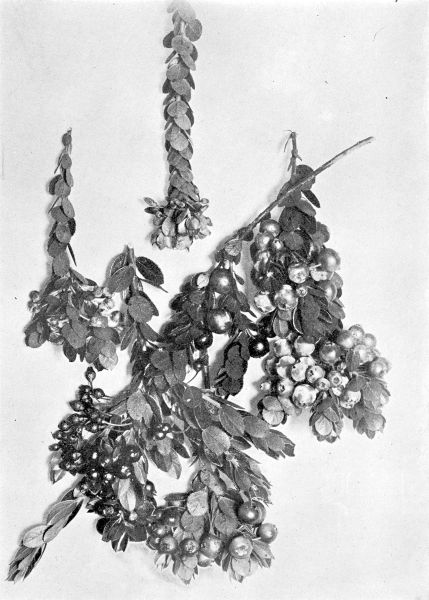
Plate LXIX.—"Ohelo."
Natural size.
Natural size.
[Pg 144]
Solanum pimpinellifolium.
The first illustration on the opposite page is that of the currant tomato; an annual found growing wild in great profusion in the low lands of our valleys. It is of weak growth, very diffuse and twiggy, and scarcely pubescent. Its obovate leaves are small with nearly entire leaflets, and very small secondary leaflets; the elongated racemes bear from 100 to 40 small, currant-like red berries, which are very sweet.
Solanum Lycopersicum.
The second illustration is that of the grape tomato, which has grayish-green leaves and slender, ascending stems. The leaves are pinnate with small, nearly entire leaflets; the main leaflets are notched or even lobed toward the base. The fruit is a bright red berry about half an inch in diameter, and is fresh and aromatic.
[Pg 145]
G. P. W. Collection. Plate LXX
Solanum pimpinellifolium.
CURRANT TOMATO.
The first illustration on the opposite page is that of the currant tomato; an annual found growing wild in great profusion in the low lands of our valleys. It is of weak growth, very diffuse and twiggy, and scarcely pubescent. Its obovate leaves are small with nearly entire leaflets, and very small secondary leaflets; the elongated racemes bear from 100 to 40 small, currant-like red berries, which are very sweet.
Solanum Lycopersicum.
GRAPE TOMATO.
The second illustration is that of the grape tomato, which has grayish-green leaves and slender, ascending stems. The leaves are pinnate with small, nearly entire leaflets; the main leaflets are notched or even lobed toward the base. The fruit is a bright red berry about half an inch in diameter, and is fresh and aromatic.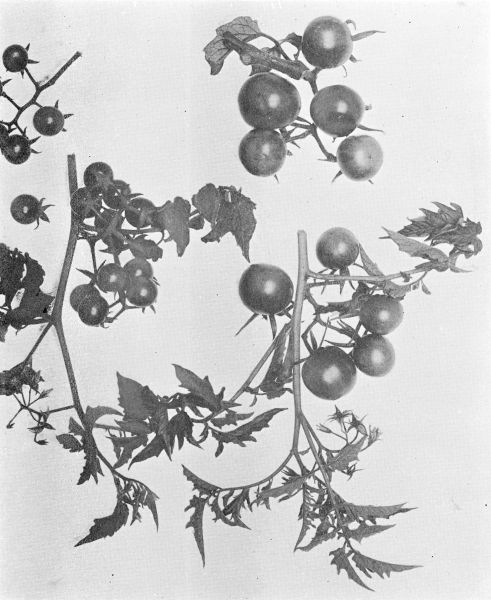
Plate LXX.—Currant Tomato. Grape Tomato.
One half natural size.
One half natural size.
[Pg 146]
Solanum nodiflorum.
This glabrous, annual, growing from 1 to 2 feet in height, is Common to most tropical countries, and in Hawaii was probably of aboriginal introduction; as the Hawaiians have many ways of using the fruits and the leaves, for medicinal purposes. This plant is found on waste land, in old pastures, and by the roadside. Its ovate leaves are dark green. The whitish flowers are small, and the fruit is a small, shiny, black berry.
[Pg 147]
G. P. W. Collection. Plate LXXI
Solanum nodiflorum.
"POPOLO."
This glabrous, annual, growing from 1 to 2 feet in height, is Common to most tropical countries, and in Hawaii was probably of aboriginal introduction; as the Hawaiians have many ways of using the fruits and the leaves, for medicinal purposes. This plant is found on waste land, in old pastures, and by the roadside. Its ovate leaves are dark green. The whitish flowers are small, and the fruit is a small, shiny, black berry.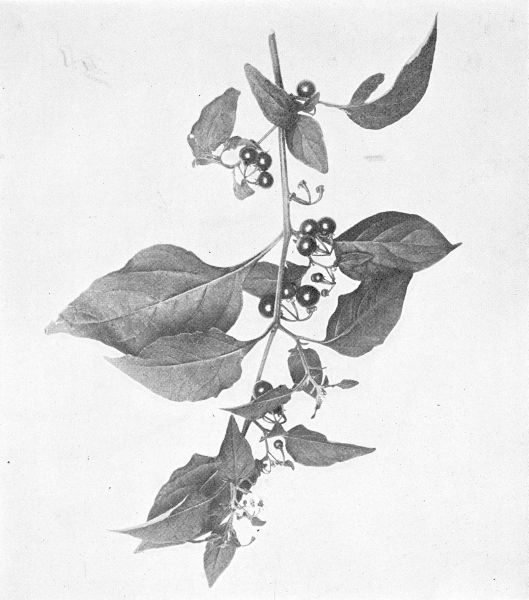
Plate LXXI.—"Popolo."
Natural size.
Natural size.
[Pg 148]
Aleurites moluccana.
The Kukui tree is easily recognizable from afar off by the pale hue of its foliage, which appears to be dusted over with flour. It is a handsome, soft wood, evergreen tree, growing to a height of from 40 to 60 feet, and is widely spread over tropical Polynesia, and a great part of Malaysia; and by all branches of the Polynesian race it is called by the same name: Kukui or Tutui. The Hawaiians tattooed their skins with a black dye which they prepared from the juice which is found in the fleshy covering of the green fruit. The leaves are alternate, 3 to 5 lobed, pubescent, and have long petioles. The yellowish-green flowers are in terminal clusters. The fruit is spherical, from 1 to 2 inches in diameter, and light-green in color, changing to a dull-brown when ripe. It contains one or more nuts, or seeds, which have a very hard, boney shell, the surface of which is uneven like the shell of a walnut. The kernels of this nut, when dried, were strung together, or bound on sticks, and served the natives for torches or candles: thus the English name of Candlenut Tree. The oil obtained from the nut was used by the Hawaiians for burning in stone lamps. The kernel, when baked, pounded, and mixed with salt and Chili peppers, makes a brown paste which is very appetizing. This is much esteemed by the Hawaiians, who call it "Inamona."
[Pg 149]
G. P. W. Collection. Plate LXXII
Aleurites moluccana.
CANDLENUT TREE—"KUKUI NUT."
The Kukui tree is easily recognizable from afar off by the pale hue of its foliage, which appears to be dusted over with flour. It is a handsome, soft wood, evergreen tree, growing to a height of from 40 to 60 feet, and is widely spread over tropical Polynesia, and a great part of Malaysia; and by all branches of the Polynesian race it is called by the same name: Kukui or Tutui. The Hawaiians tattooed their skins with a black dye which they prepared from the juice which is found in the fleshy covering of the green fruit. The leaves are alternate, 3 to 5 lobed, pubescent, and have long petioles. The yellowish-green flowers are in terminal clusters. The fruit is spherical, from 1 to 2 inches in diameter, and light-green in color, changing to a dull-brown when ripe. It contains one or more nuts, or seeds, which have a very hard, boney shell, the surface of which is uneven like the shell of a walnut. The kernels of this nut, when dried, were strung together, or bound on sticks, and served the natives for torches or candles: thus the English name of Candlenut Tree. The oil obtained from the nut was used by the Hawaiians for burning in stone lamps. The kernel, when baked, pounded, and mixed with salt and Chili peppers, makes a brown paste which is very appetizing. This is much esteemed by the Hawaiians, who call it "Inamona."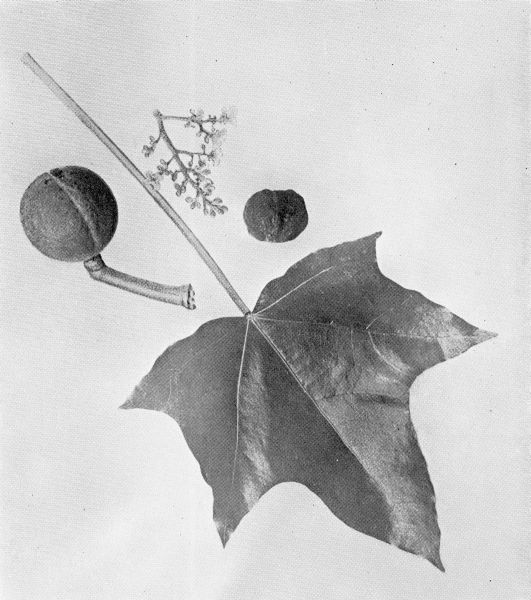
Plate LXXII.—Candlenut Tree—"Kukui Nut."
One third natural size.
One third natural size.
[Pg 150]
Terminalia Cattapa.
This deciduous tree, generally called Kamani by the Hawaiians, with its spreading branches in horizontal whorls or layers, is one of the familiar and useful shade trees of these Islands. Leaves large, opposite, broadly obovate-obtuse, very short petioled, and turning brilliant shades of red and yellow during the autumn. Flowers greenish-white on long spikes, upper ones staminate, the lower ones perfect. The almond-shaped fruit is a compressed hard, nut-like body 1 to 1½, inches long, with a thin outer covering which is sweet, and spongy. There is generally one, sometimes two, small, edible kernels found embedded in the hard body. These may be eaten raw, or roasted.
[Pg 151]
G. P. W. Collection. Plate LXXIII
Terminalia Cattapa.
TROPICAL ALMOND.
"KAMANI."
This deciduous tree, generally called Kamani by the Hawaiians, with its spreading branches in horizontal whorls or layers, is one of the familiar and useful shade trees of these Islands. Leaves large, opposite, broadly obovate-obtuse, very short petioled, and turning brilliant shades of red and yellow during the autumn. Flowers greenish-white on long spikes, upper ones staminate, the lower ones perfect. The almond-shaped fruit is a compressed hard, nut-like body 1 to 1½, inches long, with a thin outer covering which is sweet, and spongy. There is generally one, sometimes two, small, edible kernels found embedded in the hard body. These may be eaten raw, or roasted.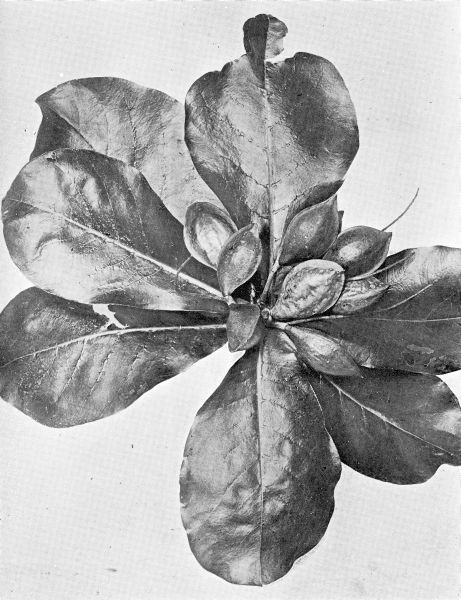
Plate LXXIII.—Tropical Almond—"Kamani."
One half natural size.
One half natural size.
[Pg 152]
Calophyllum inophyllum.
This Kamani is a large tropical tree, having shiny, leathery, evergreen foliage. Its leaves are obovate, usually marginate, and its white flowers are very fragrant. The fruit, which generally comes in clusters, is round, about the size of a large walnut, and has a thin, leathery skin which covers a boney shell, inside of which is a corky substance surrounding the seed or kernel. This tree was an early introduction to these Islands, and is commonly seen on our seacoasts.
[Pg 153]
G. P. W. Collection. Plate LXXIV
Calophyllum inophyllum.
"KAMANI."
This Kamani is a large tropical tree, having shiny, leathery, evergreen foliage. Its leaves are obovate, usually marginate, and its white flowers are very fragrant. The fruit, which generally comes in clusters, is round, about the size of a large walnut, and has a thin, leathery skin which covers a boney shell, inside of which is a corky substance surrounding the seed or kernel. This tree was an early introduction to these Islands, and is commonly seen on our seacoasts.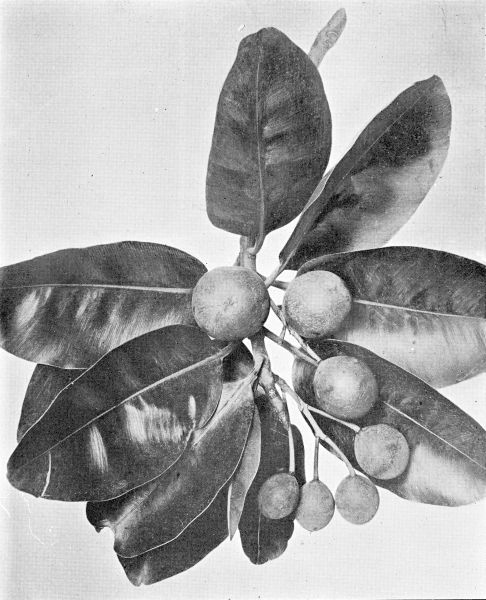
Plate LXXIV.—"Kamani."
One half natural size.
One half natural size.
[Pg 154]
[Pg 155]
G. P. W. Collection. Plate LXXV
Noronhia emarginata.
This tree is a native of Madagascar and also of Mauritius. A fine specimen may be seen at the Government Nursery, Honolulu. It is a handsome evergreen with entire, cuneate, coriacious leaves, having short petioles. The yellowish flowers come in clusters, and are quite fragrant. The fruit is a one-celled drupe, almost round, and about an inch in diameter. It is purple when ripe, and has a tough skin. The sweet, edible pulp surrounds a very large seed.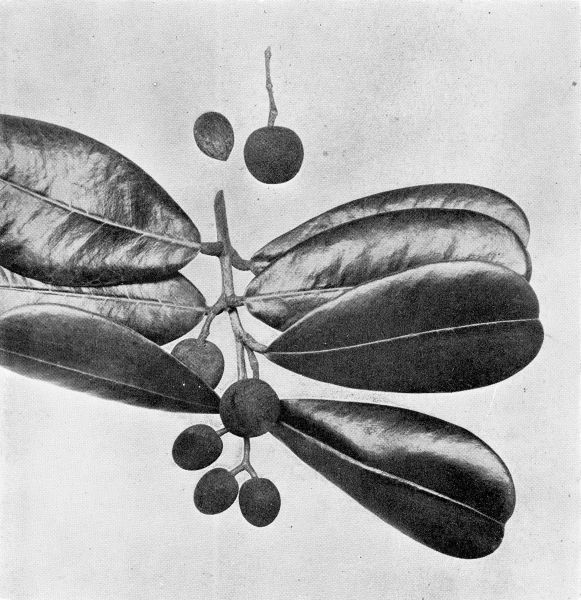
Plate LXXV.—Noronhia emarginata.
One half natural size.
One half natural size.
[Pg 156]
Castanea sativa.
This is a close-headed tree of slender growth, attaining a height of from 30 to 50 feet. Its leaves are smaller than those of other chestnuts, generally from 3 to 7 inches long, and are either rounded at the base or reduced to a long, bristle-like point. The monoecious flowers are arranged in long catkins. The small burs have a thin, papery lining, and short, widely-branching spines. The nuts are large and glossy, usually three in a bur. They are somewhat inferior in quality, but are palatable when cooked.
To my knowledge there is but one tree of this variety growing in these Islands, and it is to be found on the slopes of Tantalus, where it was planted by the Department of Agriculture.
[Pg 157]
G. P. W. Collection. Plate LXXVI
Castanea sativa.
JAPANESE CHESTNUT.
This is a close-headed tree of slender growth, attaining a height of from 30 to 50 feet. Its leaves are smaller than those of other chestnuts, generally from 3 to 7 inches long, and are either rounded at the base or reduced to a long, bristle-like point. The monoecious flowers are arranged in long catkins. The small burs have a thin, papery lining, and short, widely-branching spines. The nuts are large and glossy, usually three in a bur. They are somewhat inferior in quality, but are palatable when cooked.To my knowledge there is but one tree of this variety growing in these Islands, and it is to be found on the slopes of Tantalus, where it was planted by the Department of Agriculture.
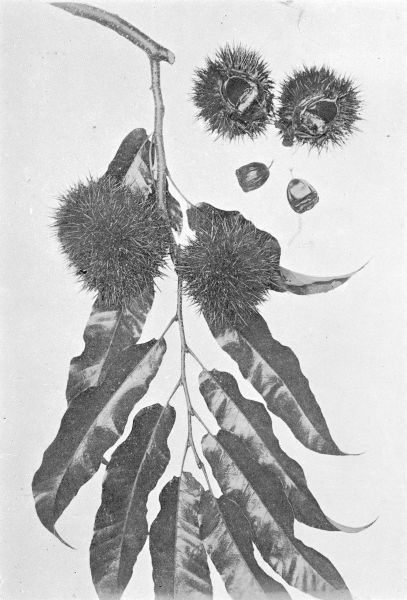
Plate LXXVI.—Japanese Chestnut.
One half natural size.
One half natural size.
[Pg 158]
Inocarpus edulis.
This tree, which is said to be a native of the Moluccas, is an evergreen of very rapid growth. Its straight trunk, with smooth, ashen-grey bark, its spreading branches, with their dense green foliage, make a very ornamental as well as useful tree. Its leaves are alternate and simple. The small, fragrant, pale yellow flowers are very numerous. The drupe is obliquely oval, and about the size of a goose egg, containing a large kernel which is edible when roasted, but is not especially palatable. The only trees of this variety growing in Hawaii are to be found at Ahuimanu Ranch, Oahu, where they fruit regularly, and the seeds germinate after being in the ground some months.
[Pg 159]
G. P. W. Collection. Plate LXXVII
Inocarpus edulis.
TAHITIAN CHESTNUT.
This tree, which is said to be a native of the Moluccas, is an evergreen of very rapid growth. Its straight trunk, with smooth, ashen-grey bark, its spreading branches, with their dense green foliage, make a very ornamental as well as useful tree. Its leaves are alternate and simple. The small, fragrant, pale yellow flowers are very numerous. The drupe is obliquely oval, and about the size of a goose egg, containing a large kernel which is edible when roasted, but is not especially palatable. The only trees of this variety growing in Hawaii are to be found at Ahuimanu Ranch, Oahu, where they fruit regularly, and the seeds germinate after being in the ground some months.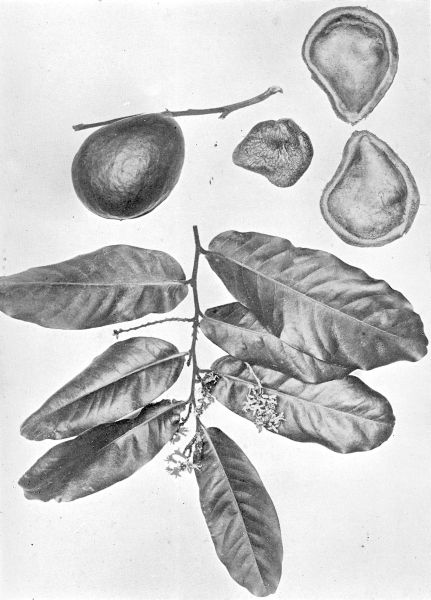
Plate LXXVII.—Tahitian Chestnut.
One third natural size.
One third natural size.
[Pg 160]
Canarium commune.
This medium-sized nut-bearing tree is found growing in Java, Guam and the Philippines, and from any one of those countries may have been introduced to Hawaii. A fine specimen may be seen at the Government Nursery, Honolulu. Its leaves are alternate, odd pinnate. The small flowers come in terminal panicles. The fruit or nut is ellipsoidal. The thick skin, which is purple-colored when ripe, covers a hard, three-lobed stone, which differs from a pecan nut only in that it is sharp at each end. The kernel is small, sweet and edible. Trees propagated from the mature nuts.
[Pg 161]
G. P. W. Collection. Plate LXXVIII
Canarium commune.
CANARY NUT.
This medium-sized nut-bearing tree is found growing in Java, Guam and the Philippines, and from any one of those countries may have been introduced to Hawaii. A fine specimen may be seen at the Government Nursery, Honolulu. Its leaves are alternate, odd pinnate. The small flowers come in terminal panicles. The fruit or nut is ellipsoidal. The thick skin, which is purple-colored when ripe, covers a hard, three-lobed stone, which differs from a pecan nut only in that it is sharp at each end. The kernel is small, sweet and edible. Trees propagated from the mature nuts.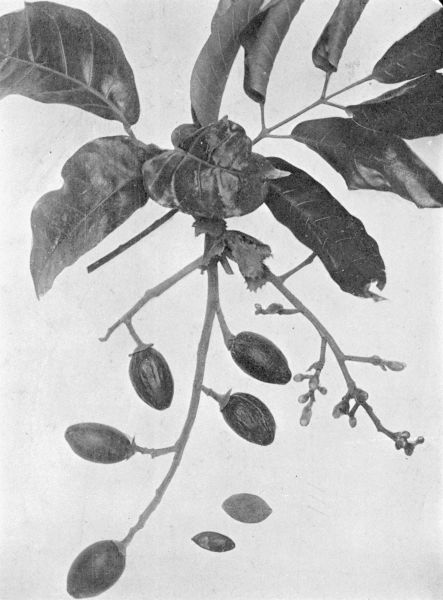
Plate LXXVIII.—Canary Nut.
One half natural size.
One half natural size.
[Pg 162]
Canarium commune.
Few trees of this round variety are to be found in Hawaii. Its leaves are smaller than those of the preceding variety, and it is a very poor bearer.
[Pg 163]
G. P. W. Collection. Plate LXXIX
Canarium commune.
CANARY NUT (round variety).
Few trees of this round variety are to be found in Hawaii. Its leaves are smaller than those of the preceding variety, and it is a very poor bearer.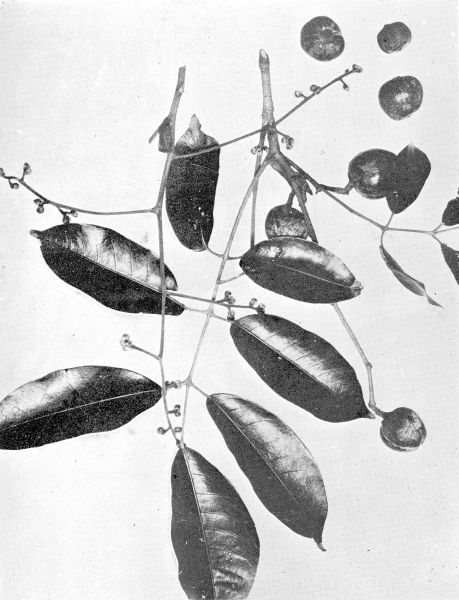
Plate LXXIX.—Canary Nut (round var.)
One half natural size.
One half natural size.
[Pg 164]
Macadamia ternifolia.
This sub-tropical Australian tree sometimes grows to a height of 60 feet, but in Hawaii is of medium size. It is symmetrical and handsome, having dark green, shiny foliage, and long tassel-like white flowers. Its glabrous leaves are sessile, oblong, lanceolate, serrate, with fine prickly teeth, and come in whorls of 3 to 4, varying in length from a few inches to a foot. Flowers small; fruit has a thick, very hard shell, which when ripe is a smooth, shiny brown. The kernel is white, crisp and sweet, and has the flavor of hazel nuts. It may be eaten either raw or roasted. The tree matures its fruit in the Fall months, and is easily propagated from the fresh nuts.
[Pg 165]
G. P. W. Collection. Plate LXXX
Macadamia ternifolia.
QUEENSLAND NUT.
This sub-tropical Australian tree sometimes grows to a height of 60 feet, but in Hawaii is of medium size. It is symmetrical and handsome, having dark green, shiny foliage, and long tassel-like white flowers. Its glabrous leaves are sessile, oblong, lanceolate, serrate, with fine prickly teeth, and come in whorls of 3 to 4, varying in length from a few inches to a foot. Flowers small; fruit has a thick, very hard shell, which when ripe is a smooth, shiny brown. The kernel is white, crisp and sweet, and has the flavor of hazel nuts. It may be eaten either raw or roasted. The tree matures its fruit in the Fall months, and is easily propagated from the fresh nuts.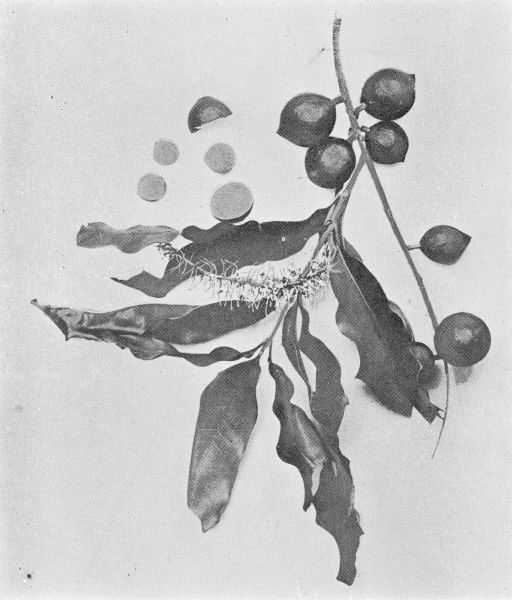
Plate LXXX.—Queensland Nut.
One half natural size.
One half natural size.
[Pg 166]
[Pg 167]
G. P. W. Collection. Plate LXXXI
Macadamia sp.
This variety of the Queensland nut has leaves and fruit larger than those of Macadamia ternifolia.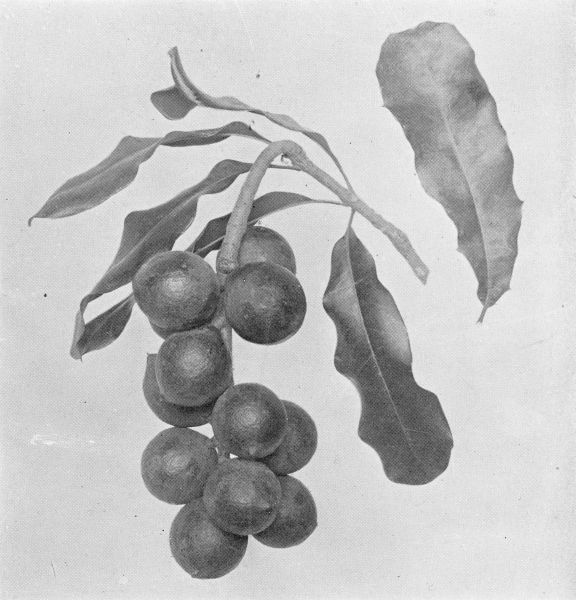
Plate LXXXI.—Macadamia sp.
One half natural size.
One half natural size.
[Pg 168]
Aegle Marmelos.
This small spinose tree is a native of tropical Asia, and although not commonly grown in Hawaii, specimens may be found in several gardens. It has alternate trifoliolate leaves, and flowers, which grow in clusters, are small and fragrant. The gourd-like fruit, with its hard shell, is from 2 to 4 inches in diameter, and is either round or pear-shaped, and although heavy and solid, it will float in water. The rind, when ripe, is a yellowish-brown color, and is studded with oil cells. The interior surface of the skin is lined with open-mouthed cells, which pour their gummy secretions into the interior of the carpel, filling it and bathing the seed. The pulp is sweet and aromatic, and is esteemed for making conserves, and also as a cooling drink.
In India, the roots and leaves are used medicinally. Bael gum is a sticky, astringent substance soluble in water. The fruit contains several large, flat, woolly seeds, which germinate readily, and the plant is also very easily propagated from root cuttings.
[Pg 169]
G. P. W. Collection. Plate LXXXII
Aegle Marmelos.
BHEL OR BAEL FRUIT.
This small spinose tree is a native of tropical Asia, and although not commonly grown in Hawaii, specimens may be found in several gardens. It has alternate trifoliolate leaves, and flowers, which grow in clusters, are small and fragrant. The gourd-like fruit, with its hard shell, is from 2 to 4 inches in diameter, and is either round or pear-shaped, and although heavy and solid, it will float in water. The rind, when ripe, is a yellowish-brown color, and is studded with oil cells. The interior surface of the skin is lined with open-mouthed cells, which pour their gummy secretions into the interior of the carpel, filling it and bathing the seed. The pulp is sweet and aromatic, and is esteemed for making conserves, and also as a cooling drink.In India, the roots and leaves are used medicinally. Bael gum is a sticky, astringent substance soluble in water. The fruit contains several large, flat, woolly seeds, which germinate readily, and the plant is also very easily propagated from root cuttings.
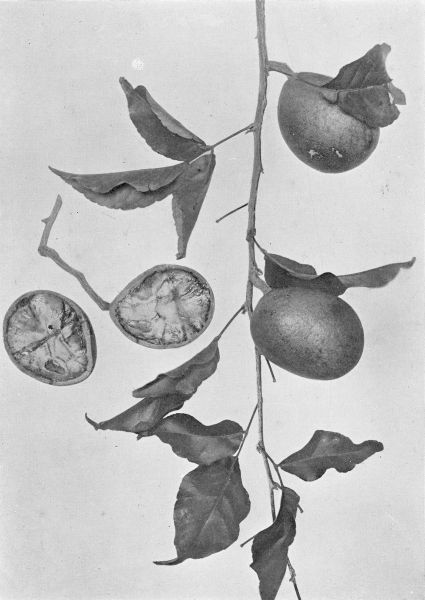
Plate LXXXII.—Bhel or Bael Fruit.
One third natural size.
One third natural size.
[Pg 170]
Diospyros decandra.
This is an evergreen tree rarely found in Hawaii. It has alternate, irregular, long, narrow leaves, shiny dark-green on the upper side, a velvety light-green on the underside, and has a long petiole. The branches are brittle, light-green, smooth and shiny when young, and after the leaves shed become woody and inclined to dry back.
The trunk and bark of the tree is covered with warty excresences. The solitary flowers are four-petaled. The edible fruit ripens in December, is round, depressed, about 2½ inches in diameter, in color light-green dotted with numerous white spots. When quite ripe the thin skin turns to a shiny-brown. The soft chocolate colored pulp is sweet and contains from 1 to 8 large flat seeds.
[Pg 171]
G. P. W. Collection. Plate LXXXIII
Diospyros decandra.
BROWN PERSIMMON.
This is an evergreen tree rarely found in Hawaii. It has alternate, irregular, long, narrow leaves, shiny dark-green on the upper side, a velvety light-green on the underside, and has a long petiole. The branches are brittle, light-green, smooth and shiny when young, and after the leaves shed become woody and inclined to dry back.The trunk and bark of the tree is covered with warty excresences. The solitary flowers are four-petaled. The edible fruit ripens in December, is round, depressed, about 2½ inches in diameter, in color light-green dotted with numerous white spots. When quite ripe the thin skin turns to a shiny-brown. The soft chocolate colored pulp is sweet and contains from 1 to 8 large flat seeds.
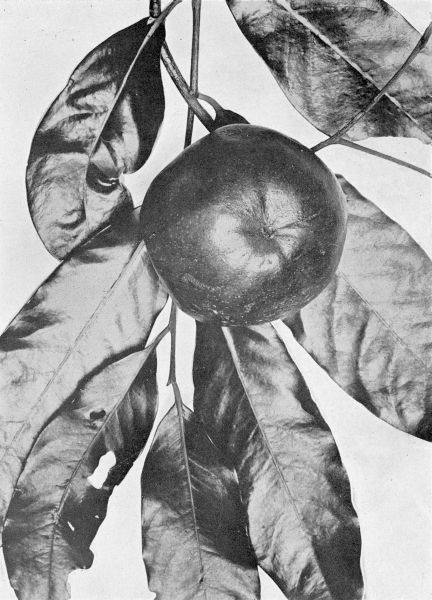
Plate LXXXIII.—Brown Persimmon.
Natural size.
Natural size.
[Pg 172]
Lucuma Rivicoa.
This small evergreen tree, which is a native of Brazil, is found only in one or two gardens in Honolulu. Its leaves are elliptic-obovate, resembling those of the mango. The yellow flowers are single, the fruit is the size and shape of a hen's egg, and has the flavor of the yolk of an egg sweetened with sugar. It has from one to three large seeds, which are easily germinated.
[Pg 173]
G. P. W. Collection. Plate LXXXIV
Lucuma Rivicoa.
EGG FRUIT.
This small evergreen tree, which is a native of Brazil, is found only in one or two gardens in Honolulu. Its leaves are elliptic-obovate, resembling those of the mango. The yellow flowers are single, the fruit is the size and shape of a hen's egg, and has the flavor of the yolk of an egg sweetened with sugar. It has from one to three large seeds, which are easily germinated.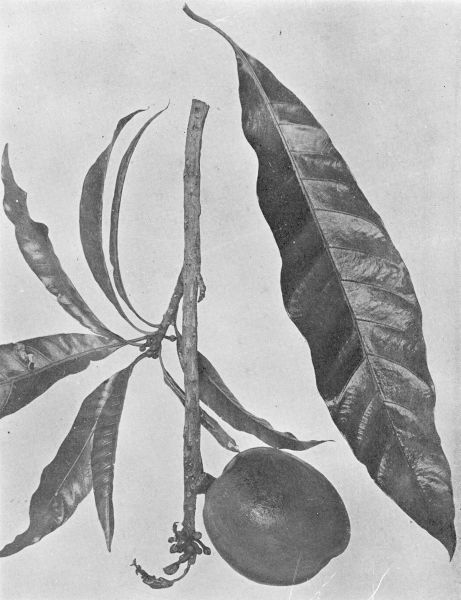
Plate LXXXIV.—Egg Fruit.
One third natural size.
One third natural size.
[Pg 174]
Eriobotrya Japonica.
The Loquat has been for many years a familiar fruit in our gardens, and is a native of China and Japan. It is a low evergreen tree with thick foliage, and in congenial climates is a profuse bearer. Its leaves are thick, oblong, and remotely toothed and grow near the ends of the branches. The white flowers grow in clusters, are very fragrant, and the fruit, which also ripens in clusters, about Christmas time, is pear-shaped, and has an agreeable acid flavor. The seeds are large, and germinate readily. Fine grafted and budded varieties have been introduced by local horticulturalists.
[Pg 175]
G. P. W. Collection. Plate LXXXV
Eriobotrya Japonica.
LOQUAT.
The Loquat has been for many years a familiar fruit in our gardens, and is a native of China and Japan. It is a low evergreen tree with thick foliage, and in congenial climates is a profuse bearer. Its leaves are thick, oblong, and remotely toothed and grow near the ends of the branches. The white flowers grow in clusters, are very fragrant, and the fruit, which also ripens in clusters, about Christmas time, is pear-shaped, and has an agreeable acid flavor. The seeds are large, and germinate readily. Fine grafted and budded varieties have been introduced by local horticulturalists.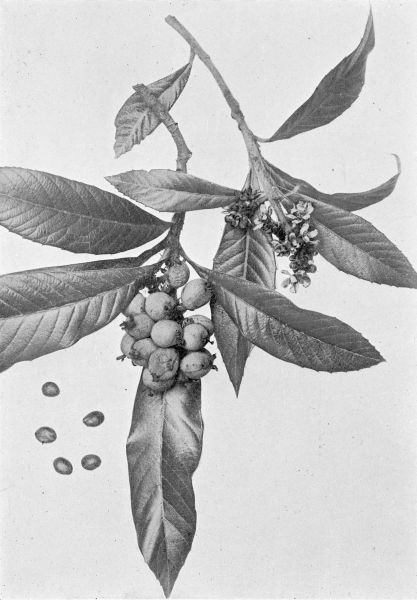
Plate LXXXV.—Loquat.
One fourth natural size.
One fourth natural size.
[Pg 176]
Litchi Chinensis.
This tree, with its dense foliage, is a native of Southern China. The first tree of this variety was brought to Hawaii by Mr. Afong, and planted at his residence in Nuuanu avenue, Honolulu, in the year 1870.
The leaves are alternate, and abruptly pinnate; the oblong leaflets are not quite opposite. Flowers pale green, small and regular, producing bunches of reddish-colored fruits, each about the size of a small walnut. They are covered with a parchment-like skin having many soft spines. The interior consists of a large seed covered with a whitish pulp of a sweetish acid flavor; this pulp when dried in the shell becomes somewhat shriveled, brownish in color, and very sweet.
The fruiting season is in July, and as there are but few trees here that bear, high prices are obtained for this rare fruit, which is much prized by the Chinese. Fresh seeds will germinate, but it requires so many years for these seedlings to bear that grafted and budded plants are imported from China.
[Pg 177]
G. P. W. Collection. Plate LXXXVI
Litchi Chinensis.
"LICHEE."
This tree, with its dense foliage, is a native of Southern China. The first tree of this variety was brought to Hawaii by Mr. Afong, and planted at his residence in Nuuanu avenue, Honolulu, in the year 1870.The leaves are alternate, and abruptly pinnate; the oblong leaflets are not quite opposite. Flowers pale green, small and regular, producing bunches of reddish-colored fruits, each about the size of a small walnut. They are covered with a parchment-like skin having many soft spines. The interior consists of a large seed covered with a whitish pulp of a sweetish acid flavor; this pulp when dried in the shell becomes somewhat shriveled, brownish in color, and very sweet.
The fruiting season is in July, and as there are but few trees here that bear, high prices are obtained for this rare fruit, which is much prized by the Chinese. Fresh seeds will germinate, but it requires so many years for these seedlings to bear that grafted and budded plants are imported from China.
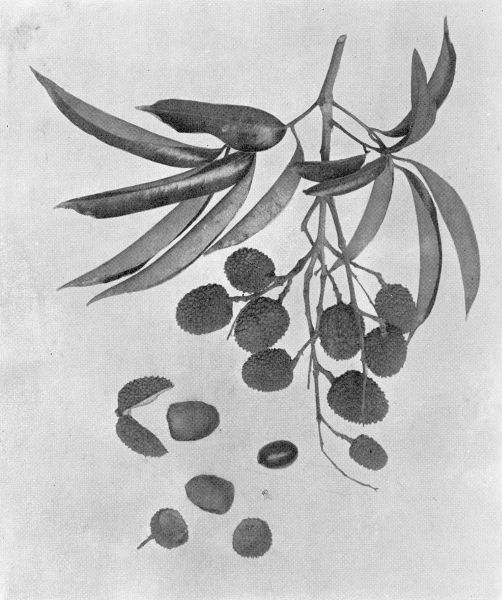
Plate LXXXVI.—"Lichee."
One third natural size.
One third natural size.
[Pg 178]
Euphoria Longana.
This tree is a native of India and Southern China. It produces its flowers and fruits at about the same time of year as does the Litchi, which it somewhat resembles, although its fruits are somewhat smaller and less palatable. The tree grows to a height of about 20 feet. It has large, alternate, pinnate leaves, and the oblong leaflets are not quite opposite; they are glossy on the upper surface, and a dusty-brown on the underside. The small flowers come in terminal panicles; and the fruit, which is borne in clusters, has a thin, brittle, somewhat rough shell. There is one large, smooth, hard seed; around which is a thin layer of sweetish, aromatic pulp. The best fruits raised here are those grown by the Chinese.
[Pg 179]
G. P. W. Collection. Plate LXXXVII
Euphoria Longana.
LONGAN.
This tree is a native of India and Southern China. It produces its flowers and fruits at about the same time of year as does the Litchi, which it somewhat resembles, although its fruits are somewhat smaller and less palatable. The tree grows to a height of about 20 feet. It has large, alternate, pinnate leaves, and the oblong leaflets are not quite opposite; they are glossy on the upper surface, and a dusty-brown on the underside. The small flowers come in terminal panicles; and the fruit, which is borne in clusters, has a thin, brittle, somewhat rough shell. There is one large, smooth, hard seed; around which is a thin layer of sweetish, aromatic pulp. The best fruits raised here are those grown by the Chinese.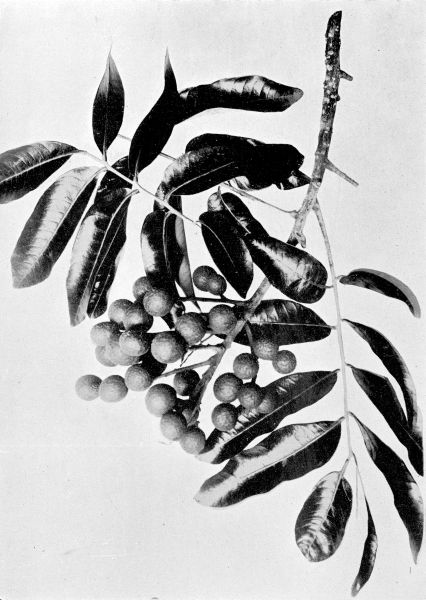
Plate LXXXVII.—Longan.
One third natural size.
One third natural size.
[Pg 180]
Morus nigra.
This low-growing tree is a native of southwestern Russia and Persia. It has rough, dark-green leaves, usually not lobed. The thick, fleshy fruit is variable in size. The mulberry grows readily from cuttings.
[Pg 181]
G. P. W. Collection. Plate LXXXVIII
Morus nigra.
MULBERRY.
This low-growing tree is a native of southwestern Russia and Persia. It has rough, dark-green leaves, usually not lobed. The thick, fleshy fruit is variable in size. The mulberry grows readily from cuttings.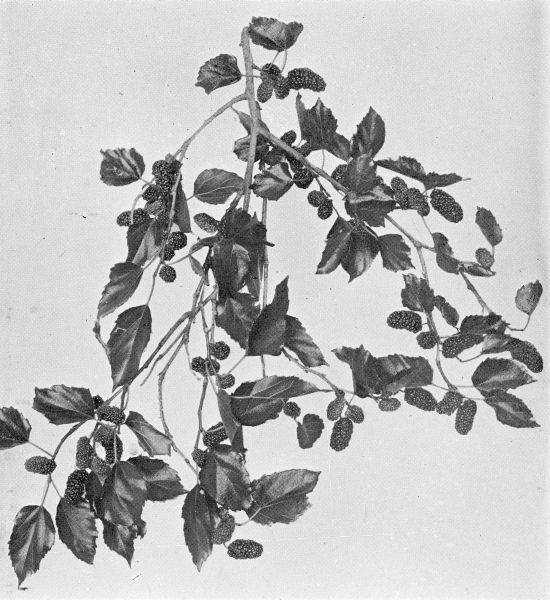
Plate LXXXVIII.—Mulberry.
One third natural size.
One third natural size.
[Pg 182]
Garcinia mangostana.
This tree is a native of Sumatra and of the Islands of the Eastern Archipelago. It is of medium size, the stem rising to a height of about 20 feet; and its branches coming out in regular order give the head of the tree the form of a parabola. The leaves are about 8 inches long and 4 inches broad at the middle; they are a beautiful green on the upper side and a delicate olive on the under side. The flowers resemble a single rose with dark-red petals. The fruit is round, about the size of a small orange, and has a characteristic persistent calyx. The shell is at first green, and when ripe changes to purplish-brown marked with yellow spots. The Mangosteen is called the queen of fruits, and the tree upon which it is produced is most graceful and beautiful.
Those who have tasted this fruit in its perfection declare it to be indescribably delicious. The Mangosteen must have a hot, moist, and fairly equable climate throughout the year.
Many Mangosteen trees have been brought to Hawaii, and have received intelligent care, but they have not thrived well; and have eventually died. Only two have ever produced fruit; one in the garden of Mr. Francis Gay of Kauai, which bears its fruit annually, and the other tree at Lahaina, Maui, in the garden formerly the property of Mr. Harry Turton.
[Pg 183]
G. P. W. Collection. Plate LXXXIX
Garcinia mangostana.
MANGOSTEEN.
This tree is a native of Sumatra and of the Islands of the Eastern Archipelago. It is of medium size, the stem rising to a height of about 20 feet; and its branches coming out in regular order give the head of the tree the form of a parabola. The leaves are about 8 inches long and 4 inches broad at the middle; they are a beautiful green on the upper side and a delicate olive on the under side. The flowers resemble a single rose with dark-red petals. The fruit is round, about the size of a small orange, and has a characteristic persistent calyx. The shell is at first green, and when ripe changes to purplish-brown marked with yellow spots. The Mangosteen is called the queen of fruits, and the tree upon which it is produced is most graceful and beautiful.Those who have tasted this fruit in its perfection declare it to be indescribably delicious. The Mangosteen must have a hot, moist, and fairly equable climate throughout the year.
Many Mangosteen trees have been brought to Hawaii, and have received intelligent care, but they have not thrived well; and have eventually died. Only two have ever produced fruit; one in the garden of Mr. Francis Gay of Kauai, which bears its fruit annually, and the other tree at Lahaina, Maui, in the garden formerly the property of Mr. Harry Turton.
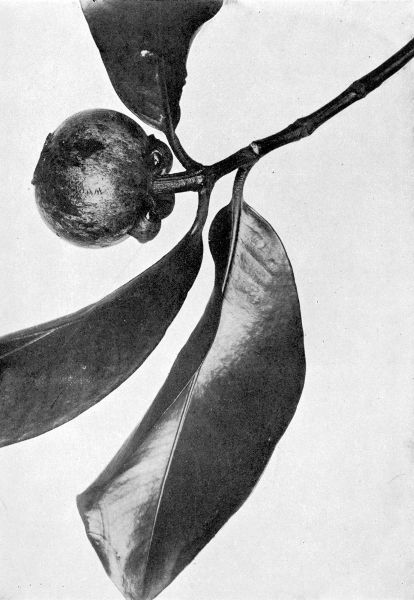
Plate LXXXIX.—Mangosteen.
Two thirds natural size.
Two thirds natural size.
[Pg 184]
[Pg 185]
G. P. W. Collection. Plate XC
Garcinia Xanthochymus.
This handsome tree is a native of India, and was first introduced to Hawaii by Mr. Albert Jaeger. It has long, narrow, leathery leaves of a bright, glossy green. The flowers, which have four petals, appear at the axil of the leaves, and the fruit, which is about the size of a small quince, has a smooth, thin skin, which is yellow when ripe. The firm pulp is golden yellow, very juicy, and sour, and the seeds are large. This variety is common in the Islands, and has often been mistaken for the Mangosteen. It ripens its fruit in October and November. This variety has been used to inarch the garcina mangostana upon.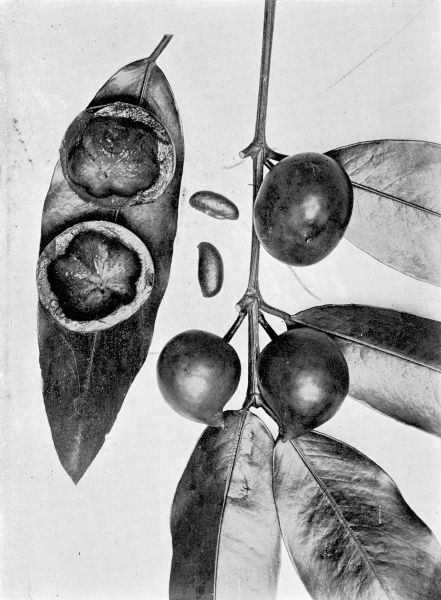
Plate XC.—Garcinia Xanthochymus.
One third natural size.
One third natural size.
[Pg 186]
[Pg 187]
G. P. W. Collection. Plate XCI
Bunchosia sp.
This tree was doubtless introduced to Hawaii from South America. There are only two specimens of its kind growing in Honolulu. Its fruits are edible, but not especially palatable. It is a small tree having terete branches, and its opposite leaves are oblong-elliptical, dark-green above and a lighter, somewhat glossy-green beneath. The petioles are short. The axillary inflorescence comes in long, slender cymes, and the five-petaled flowers are yellow. When ripe, the obovate fruit is a purplish-yellow, having usually two seeds, and but one seed when abortive.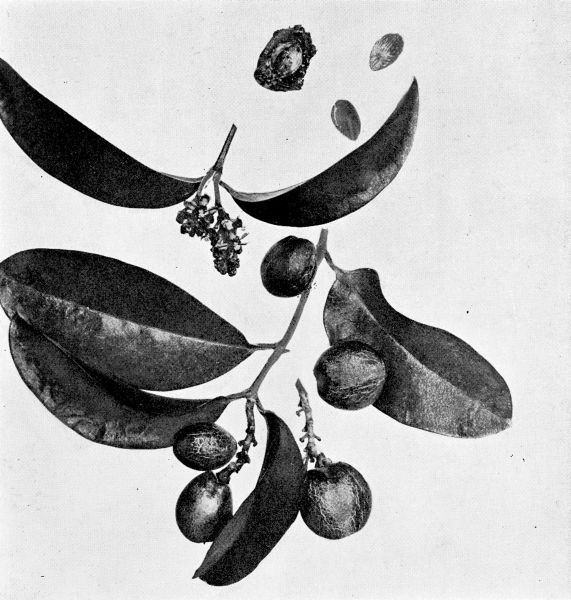
Plate XCI.—Bunchosia sp.
One half natural size.
One half natural size.
[Pg 188]
Malpighia glabra.
This small shrub is a native of the West Indies. Its dull-green leaves are opposite, ovate and glabrous, either entire or spiny-toothed. The rose-colored flowers are axillary and five-petaled. The bright red fruit is about the size of a cherry, and has a thin skin, and its acid pulp is used for jam and preserves. The seeds or stones are large, four-angled, and germinate readily; plants are also produced by cuttings. Though not common in these Islands, there are, however, a few specimens of this plant to be found in several of the private gardens of Honolulu.
[Pg 189]
G. P. W. Collection. Plate XCII
Malpighia glabra.
BARBADOS CHERRY.
This small shrub is a native of the West Indies. Its dull-green leaves are opposite, ovate and glabrous, either entire or spiny-toothed. The rose-colored flowers are axillary and five-petaled. The bright red fruit is about the size of a cherry, and has a thin skin, and its acid pulp is used for jam and preserves. The seeds or stones are large, four-angled, and germinate readily; plants are also produced by cuttings. Though not common in these Islands, there are, however, a few specimens of this plant to be found in several of the private gardens of Honolulu.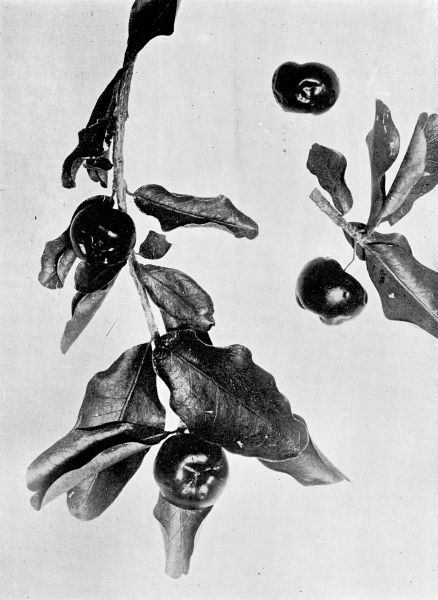
Plate XCII.—Barbados Cherry.
Natural size.
Natural size.
[Pg 190]
Theobroma Cacao.
In Hawaii this tropical tree grows to a height of from 10 to 30 feet. It has large, pointed leaves, and the new growth is wine-colored. The flowers appear on the trunk and mature branches, and the fruit which follows is about 8 to 12 inches long, and is called the pod; inside of this pod are beans or seeds, from which the commercial product called cocoa is made, through a process of drying and curing. Chocolate is the term used for the sweetened preparations of the roasted and ground beans, with a large proportion of the original fat retained. Cocoa preparations are the same material in fine powder, sweetened and unsweetened, with a greater part of the fat extracted.
Cacao cultivation has never been successfully attempted in Hawaii. However, a few isolated trees can be found at Ahuimanu Ranch, Oahu, where they were planted by the Catholic brothers as an experiment some years ago.
[Pg 191]
G. P. W. Collection. Plate XCIII
Theobroma Cacao.
CHOCOLATE, COCOA.
In Hawaii this tropical tree grows to a height of from 10 to 30 feet. It has large, pointed leaves, and the new growth is wine-colored. The flowers appear on the trunk and mature branches, and the fruit which follows is about 8 to 12 inches long, and is called the pod; inside of this pod are beans or seeds, from which the commercial product called cocoa is made, through a process of drying and curing. Chocolate is the term used for the sweetened preparations of the roasted and ground beans, with a large proportion of the original fat retained. Cocoa preparations are the same material in fine powder, sweetened and unsweetened, with a greater part of the fat extracted.Cacao cultivation has never been successfully attempted in Hawaii. However, a few isolated trees can be found at Ahuimanu Ranch, Oahu, where they were planted by the Catholic brothers as an experiment some years ago.
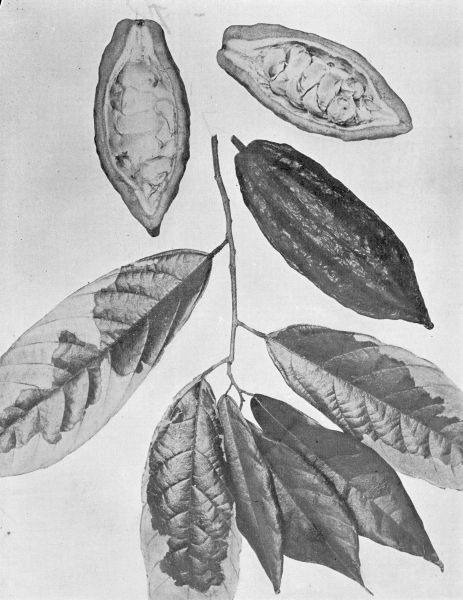
Plate XCIII.—Chocolate, Cocoa.
One fourth natural size.
One fourth natural size.
[Pg 192]
Hibiscus Sabdariffa.
This bush or shrub is a showy annual growing to a height of from 5 to 7 feet. The stems are reddish, and the pale yellow flowers solitary. The leaves are palmate and of a light-green color. It is widely cultivated in the tropics, in Florida, and in Southern California; and also thrives in Hawaii. The dark crimson calyces are very fleshy and make excellent jelly, which has somewhat the flavor of the cranberry.
[Pg 193]
G. P. W. Collection. Plate XCIV
Hibiscus Sabdariffa.
ROSELLE.
This bush or shrub is a showy annual growing to a height of from 5 to 7 feet. The stems are reddish, and the pale yellow flowers solitary. The leaves are palmate and of a light-green color. It is widely cultivated in the tropics, in Florida, and in Southern California; and also thrives in Hawaii. The dark crimson calyces are very fleshy and make excellent jelly, which has somewhat the flavor of the cranberry.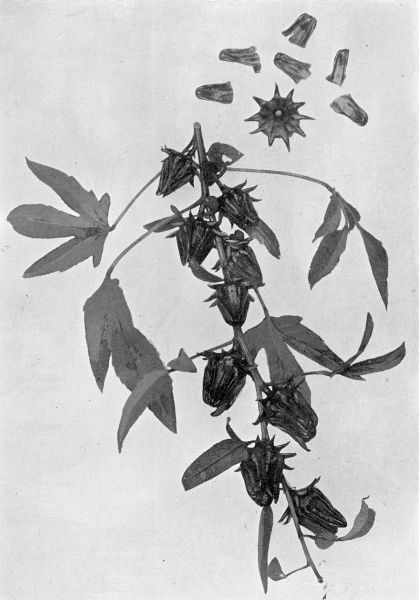
Plate XCIV.—Roselle.
One third natural size.
One third natural size.
[Pg 194]
The rind is composed of plates which may be detached when the fruit is quite ripe. It is green in color until it ripens, when there appears a slight tinge of yellow. The creamy-white pulp has a most delicious flavor, somewhat resembling the banana, and also like the pineapple. It requires 18 months to mature the fruit. Propagation is by cuttings.
[Pg 195]
G. P. W. Collection. Plate XCV
Monstera deliciosa.
The Monstera deliciosa, one of the grandest of arid plants, is a native of the mountainous regions of Guatamala and Brazil. It climbs to a height of 12 or more feet, and its leaf stalks are often 3 feet long. It obtains nourishment from the tree upon which it attaches itself. Its leaves are huge and perforated. As the plant climbs, the stems emit aerial roots, many of which never reach the ground. The fruit which has the appearance of an elongated pine-cone, grows to a length of from 6 to 12 inches, and is about 2½ inches in diameter.The rind is composed of plates which may be detached when the fruit is quite ripe. It is green in color until it ripens, when there appears a slight tinge of yellow. The creamy-white pulp has a most delicious flavor, somewhat resembling the banana, and also like the pineapple. It requires 18 months to mature the fruit. Propagation is by cuttings.
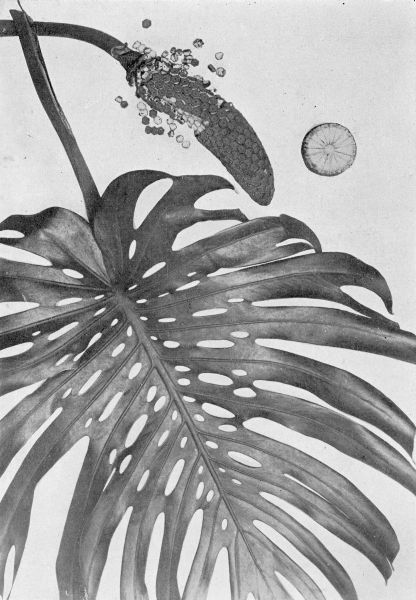
Plate XCV.—Monstera deliciosa.
One fourth natural size.
One fourth natural size.
[Pg 196]
Anacardium occidentale.
This spreading tree is a native of the West Indies; and although it is seen in several gardens of our Islands, it is not common. The first tree of its kind was planted by Mr. Henry Davis in his grounds at Punahou. The tree grows to a height of from 15 to 20 feet. The light-green, leathery leaves are oval and rough, its pink flowers have a peculiar, strong fragrance. The fruit consists of two distinct parts; the heart-shaped nut or seed and the fleshy, pear-shaped receptacle to which it is attached. This receptacle is from 2 to 4 inches long, is either red or yellow, and is very juicy and astringent. The nut or seed is edible when roasted. It is much appreciated in the West Indies. While being roasted the fumes are said to be poisonous.
[Pg 197]
G. P. W. Collection. Plate XCVI
Anacardium occidentale.
CASHEW NUT.
This spreading tree is a native of the West Indies; and although it is seen in several gardens of our Islands, it is not common. The first tree of its kind was planted by Mr. Henry Davis in his grounds at Punahou. The tree grows to a height of from 15 to 20 feet. The light-green, leathery leaves are oval and rough, its pink flowers have a peculiar, strong fragrance. The fruit consists of two distinct parts; the heart-shaped nut or seed and the fleshy, pear-shaped receptacle to which it is attached. This receptacle is from 2 to 4 inches long, is either red or yellow, and is very juicy and astringent. The nut or seed is edible when roasted. It is much appreciated in the West Indies. While being roasted the fumes are said to be poisonous.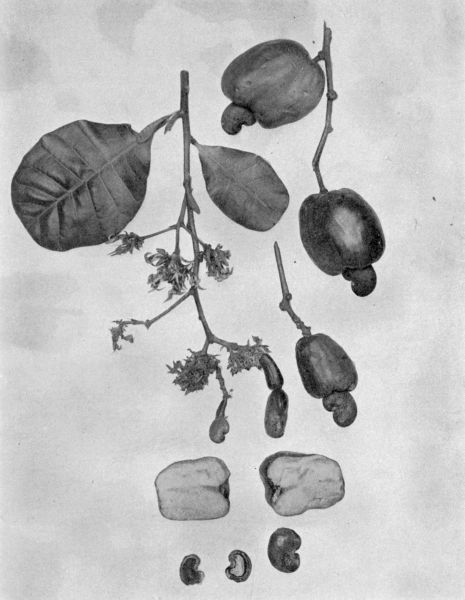
Plate XCVI.—Cashew Nut.
One half natural size.
One half natural size.
[Pg 198]
Ziziphus Jujuba.
This tree, which grows to a height of from 15 to 20 feet, is a native of China, from which country it was probably introduced to these Islands. Its branches are usually prickly; the leaves, which are from 1 to 3 inches in length, are alternate, ovate to oblong, obtuse, and are dark green and glabrous above, and tawny and nearly white beneath. The flowers are axillary. The yellow fruit, which ripens in March, is about the size of a cherry. When eaten raw, it has a bitter flavor, but it makes an excellent preserve.
[Pg 199]
G. P. W. Collection. Plate XCVII
Ziziphus Jujuba.
"JUJUBE."
This tree, which grows to a height of from 15 to 20 feet, is a native of China, from which country it was probably introduced to these Islands. Its branches are usually prickly; the leaves, which are from 1 to 3 inches in length, are alternate, ovate to oblong, obtuse, and are dark green and glabrous above, and tawny and nearly white beneath. The flowers are axillary. The yellow fruit, which ripens in March, is about the size of a cherry. When eaten raw, it has a bitter flavor, but it makes an excellent preserve.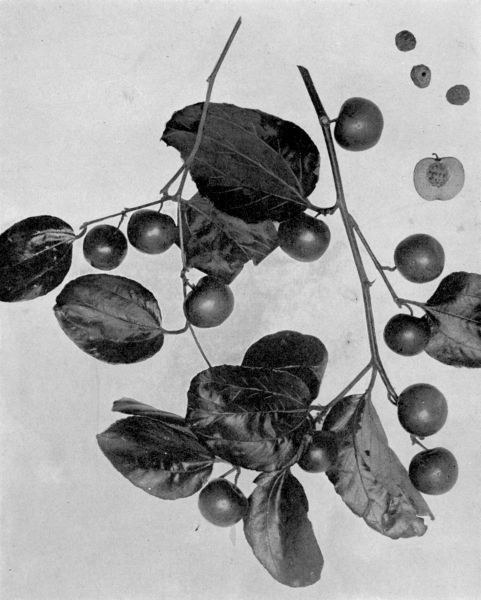
Plate XCVII.—"Jujube."
One half natural size.
One half natural size.
[Pg 200]
[Pg 201]
G. P. W. Collection. Plate XCVIII
Phyllanthus emblica.
There is but one tree of this species that has ever fruited in Honolulu. It is to be found growing in the grounds of the Royal Mausoleum, Nuuanu Valley. It is of medium height, having a crooked trunk, and its thin, scattered branches grow irregularly. The numerous alternate leaves are pinnate, the obtuse leaflets growing close together, and are from one-half to three-fourths of an inch in length. Its minute flowers are greenish-yellow. The round, six-striated fruit is smooth and fleshy, and three-fourths to one inch in diameter. The seeds are enclosed in three or more obovate cells, each cell containing two seeds. The pulp is hard and bitter, but when cooked makes an excellent preserve.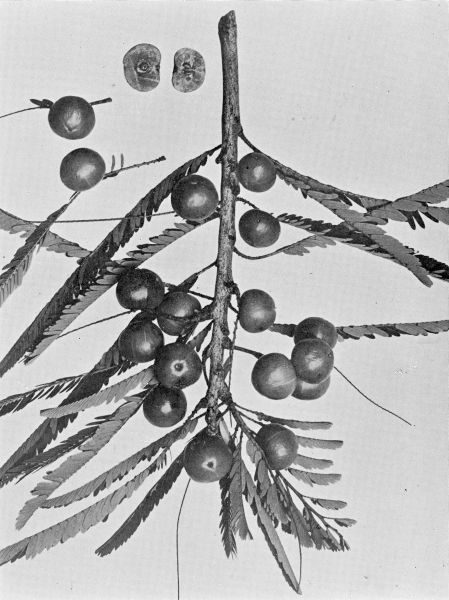
Plate XCVIII. Phyllanthus emblica.
One half natural size.
One half natural size.
[Pg 202]
Phyllanthus distichus.
This is a low-growing tree having large pinnate leaves with acute, alternate leaflets, which are about one to two inches in length. Its flowers grow on separate branches below the foliage. The fleshy, green fruit, which is borne in long clusters, is acid and astringent, but when made into preserves or pickles is palatable. The root and seeds have medicinal qualities. There is but one tree of this species in Honolulu. It is growing in the garden of Mr. Wm. Wolters.
[Pg 203]
G. P. W. Collection. Plate XCIX
Phyllanthus distichus.
OTAHEITI GOOSEBERRY.
This is a low-growing tree having large pinnate leaves with acute, alternate leaflets, which are about one to two inches in length. Its flowers grow on separate branches below the foliage. The fleshy, green fruit, which is borne in long clusters, is acid and astringent, but when made into preserves or pickles is palatable. The root and seeds have medicinal qualities. There is but one tree of this species in Honolulu. It is growing in the garden of Mr. Wm. Wolters.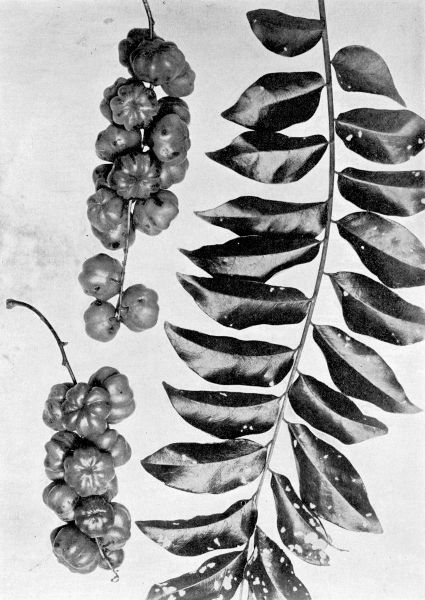
Plate XCIX.—Otaheiti Gooseberry.
One half natural size.
One half natural size.
[Pg 204]
Olea Europea.
The Olive, which is a native of Southwestern Asia, is not a tree of any great height, but is very longlived, and yields prolifically. Although not cultivated to any extent, the Olive has been growing in Hawaii for many years. However, it has fruited only in a few favorable localities, and nothing has ever been done to test its value commercially.
The tree thrives best in a warm, dry atmosphere, where the soil is rich and well drained. Long-continued droughts so detrimental to most plants will affect the Olive but slightly. The tree requires judicious pruning immediately after the fruit is gathered, when the sap is comparatively at rest. The small, thick leaves are lanceolate, opposite, and usually entire; they are dull green above and silvery beneath. The small white flowers, which come in panicles, are usually imperfect. The fruit is a small, ellipsoid drupe, which is bluish-black when ripe. Its oil is an important product. The Olive may be propagated from seeds, cuttings, layers, suckers and pieces of the old stumps. The seeds require some time to germinate, and the growth of the young plant is slow.
[Pg 205]
G. P. W. Collection. Plate C
Olea Europea.
OLIVE.
The Olive, which is a native of Southwestern Asia, is not a tree of any great height, but is very longlived, and yields prolifically. Although not cultivated to any extent, the Olive has been growing in Hawaii for many years. However, it has fruited only in a few favorable localities, and nothing has ever been done to test its value commercially.The tree thrives best in a warm, dry atmosphere, where the soil is rich and well drained. Long-continued droughts so detrimental to most plants will affect the Olive but slightly. The tree requires judicious pruning immediately after the fruit is gathered, when the sap is comparatively at rest. The small, thick leaves are lanceolate, opposite, and usually entire; they are dull green above and silvery beneath. The small white flowers, which come in panicles, are usually imperfect. The fruit is a small, ellipsoid drupe, which is bluish-black when ripe. Its oil is an important product. The Olive may be propagated from seeds, cuttings, layers, suckers and pieces of the old stumps. The seeds require some time to germinate, and the growth of the young plant is slow.
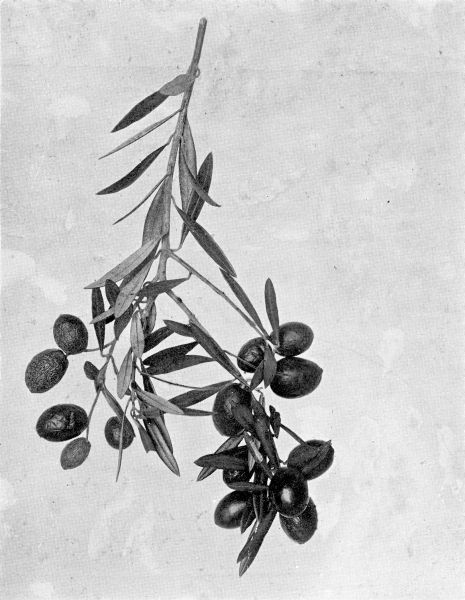
Plate C.—Olive.
One half natural size.
One half natural size.
[Pg 206]
Vitis Labrusca.
This variety of grape was early introduced to these Islands, and has become very popular. It is a hardy vine, variable in productiveness, and is practically the only grape grown in any quantity in Hawaii. The leaves are of medium size, often roundish and thick; their upper surface is dark-green, the under surface is whitish-green. The Isabella is an attractive blue-black grape, bearing in large, well-formed clusters, having a thick bloom. The muskiness of the thick skin is somewhat objectionable.
[Pg 207]
G. P. W. Collection. Plate CI
Vitis Labrusca.
"ISABELLA GRAPE."
This variety of grape was early introduced to these Islands, and has become very popular. It is a hardy vine, variable in productiveness, and is practically the only grape grown in any quantity in Hawaii. The leaves are of medium size, often roundish and thick; their upper surface is dark-green, the under surface is whitish-green. The Isabella is an attractive blue-black grape, bearing in large, well-formed clusters, having a thick bloom. The muskiness of the thick skin is somewhat objectionable.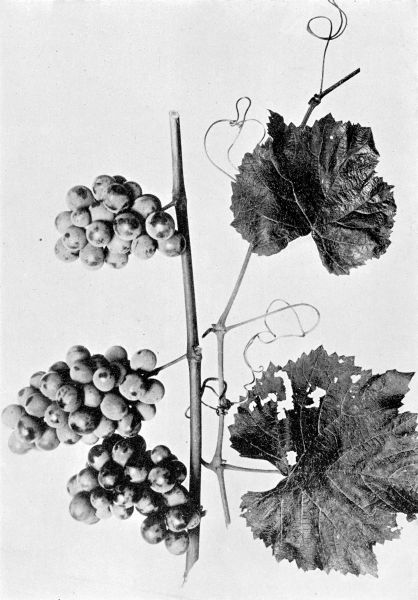
Plate CI.—"Isabella Grape."
One half natural size.
One half natural size.
[Pg 208]
Pyrus Sinensis.
This tree is a vigorous and clean grower, having strong, thick shoots, beautiful foliage, and very ornamental fruit. The dark-green leaves are broadly ovate, and long-pointed, with their margins thickly furnished with very sharp, almost bristle-like teeth. The large white flowers appear rather in advance of the leaves. The fruit is hard and rough, about 2½ inches in diameter, with generally a depression about the stem. The flesh is tough and gritty, but is very delicious when baked. Propagation is by cuttings.
[Pg 209]
G. P. W. Collection. Plate CII
Pyrus Sinensis.
SAND PEAR.
This tree is a vigorous and clean grower, having strong, thick shoots, beautiful foliage, and very ornamental fruit. The dark-green leaves are broadly ovate, and long-pointed, with their margins thickly furnished with very sharp, almost bristle-like teeth. The large white flowers appear rather in advance of the leaves. The fruit is hard and rough, about 2½ inches in diameter, with generally a depression about the stem. The flesh is tough and gritty, but is very delicious when baked. Propagation is by cuttings.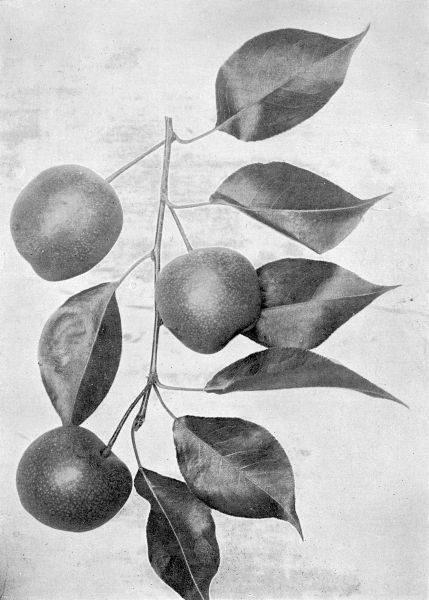
Plate CII.—Sand Pear.
One half natural size.
One half natural size.
[Pg 210]
Passiflora quadrangularis.
This tall, strong climber is a native of tropical America. Its leaves are broadly ovate, and the strong stems are purplish in color. The large, interesting flowers are from 3 to 5 inches across. The sepals are linear and violet shaded, the petals are very narrow and lilac. The many rows of filaments in the crown are violet with bars of white below the middle, the inner and shorter set being deep violet. The oblong fruit attains a size from 5 to 9 inches in length, and in color is a pale, yellowish green. The succulent, edible pulp of its hollow center has an agreeable sub-acid flavor, and contains many flat seeds. This vine bears well where there are bees; artificial fertilization also increases the number of its fruits.
[Pg 211]
G. P. W. Collection. Plate CIII
Passiflora quadrangularis.
GRANADILLA VINE.
This tall, strong climber is a native of tropical America. Its leaves are broadly ovate, and the strong stems are purplish in color. The large, interesting flowers are from 3 to 5 inches across. The sepals are linear and violet shaded, the petals are very narrow and lilac. The many rows of filaments in the crown are violet with bars of white below the middle, the inner and shorter set being deep violet. The oblong fruit attains a size from 5 to 9 inches in length, and in color is a pale, yellowish green. The succulent, edible pulp of its hollow center has an agreeable sub-acid flavor, and contains many flat seeds. This vine bears well where there are bees; artificial fertilization also increases the number of its fruits.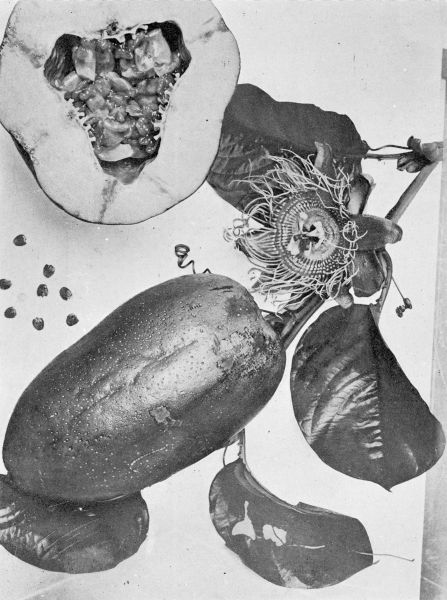
Plate CIII.—Granadilla Vine.
One half natural size.
One half natural size.
[Pg 212]
Passiflora edulis.
This strong, woody vine is native of Brazil, and is naturalized in most tropical countries. Its first introduction to these islands was at Lilikoi, district of Makawao, Maui, whence its native name. Its serrate leaves are large and deeply three-lobed; the white flowers are tinted with purple. The fruit is oblong, globular, and when ripe is purple in color; its shell-like skin is thick and crisp. The orange-colored edible pulp is very fragrant, and is filled with small seeds, which germinate readily.
[Pg 213]
G. P. W. Collection. Plate CIV
Passiflora edulis.
PURPLE WATER LEMON.
"LILIKOI."
This strong, woody vine is native of Brazil, and is naturalized in most tropical countries. Its first introduction to these islands was at Lilikoi, district of Makawao, Maui, whence its native name. Its serrate leaves are large and deeply three-lobed; the white flowers are tinted with purple. The fruit is oblong, globular, and when ripe is purple in color; its shell-like skin is thick and crisp. The orange-colored edible pulp is very fragrant, and is filled with small seeds, which germinate readily.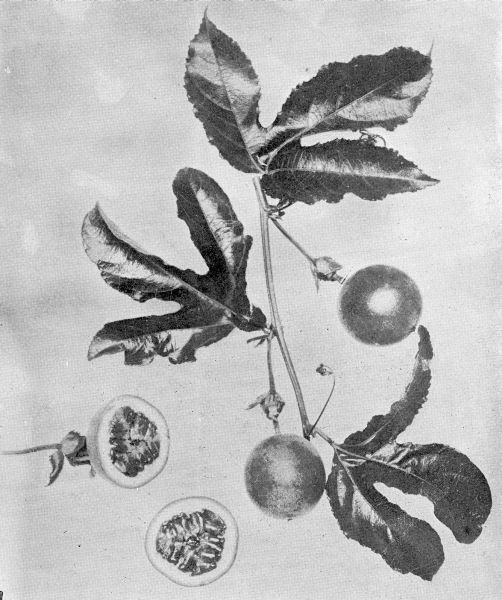
Plate CIV.—Purple Water Lemon—"Lilikoi."
One half natural size.
One half natural size.
[Pg 214]
Passiflora laurifolia.
This strong-growing, glabrous vine, climbing by tendrils, is a native of tropical America. The date when it was introduced to Hawaii, and by whom, is not known; but in the Hilo and Hamakua districts of Hawaii this variety grows wild. Its thick leaves are oval, oblong and entire, and have a short, sharp point. The flowers are about 2½, inches across, are white, with red spots on them. The fruit is slightly oblong, 2 inches in diameter, and very regular in size and shape. When ripe, it is yellow spotted with white. It has a medium-hard shell or skin, and the edible pulp is whitish-yellow, and contains many flat, black seeds.
[Pg 215]
G. P. W. Collection. Plate CV
Passiflora laurifolia.
YELLOW WATER LEMON.
This strong-growing, glabrous vine, climbing by tendrils, is a native of tropical America. The date when it was introduced to Hawaii, and by whom, is not known; but in the Hilo and Hamakua districts of Hawaii this variety grows wild. Its thick leaves are oval, oblong and entire, and have a short, sharp point. The flowers are about 2½, inches across, are white, with red spots on them. The fruit is slightly oblong, 2 inches in diameter, and very regular in size and shape. When ripe, it is yellow spotted with white. It has a medium-hard shell or skin, and the edible pulp is whitish-yellow, and contains many flat, black seeds.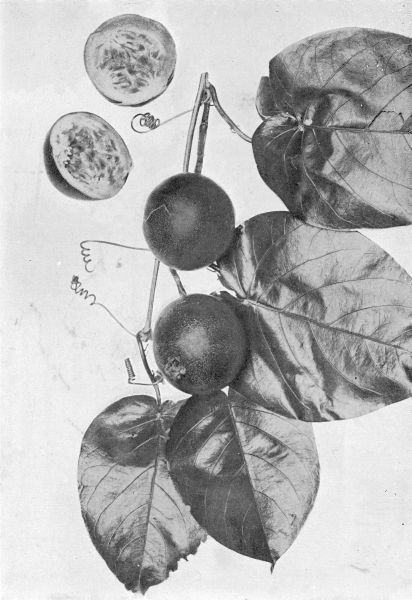
Plate CV.—Yellow Water Lemon.
One third natural size.
One third natural size.
[Pg 216]
[Pg 217]
G. P. W. Collection. Plate CVI
Passiflora alata.
This is a strong, vigorous vine, very suitable for arbors and trellises. It is not commonly found in Hawaii; however, a very fine specimen of its kind is growing in Dr. St. D. G. Walter's garden in Honolulu. The leaves are oval to ovate, the petioles having two glands. The fragrant purple flowers are about two inches in diameter. The ovoid-pointed fruit has a tough, leathery shell which, when green, is six-striated, with white stripes; when quite ripe the fruit is a dull orange-yellow. The numerous seeds are imbedded in the juicy, scented pulp, which is aromatic and delicious. Propagation is by seed and by cuttings.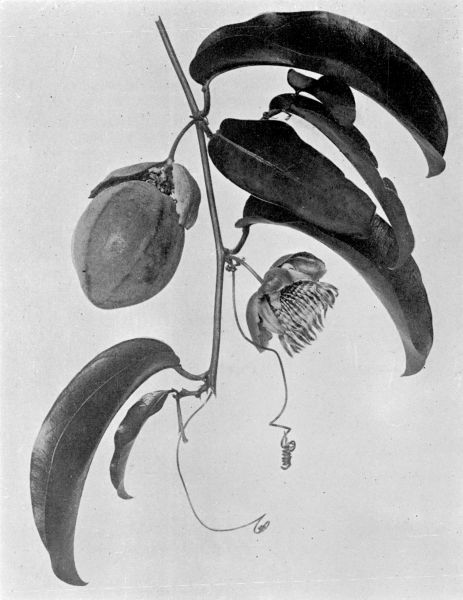
Plate CVI.—Passiflora alata.
One half natural size.
One half natural size.
[Pg 218]
[Pg 219]
G. P. W. Collection. Plate CVII
Passiflora, var. foetida.
This strong and hardy vine grows well on arbors and trellises. Its leaves are three-cleft, and have long petioles; and spiral tendrils spring from the axils. The single, pale-green flowers are surrounded by a green, lace-like covering. The fruit is nearly globular, and slightly pointed; it is about three-fourths of an inch in diameter, and when ripe is a bright scarlet.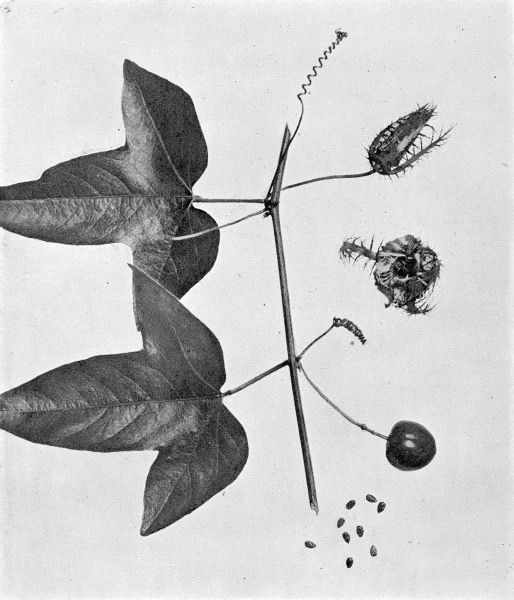
Plate CVII. Passiflora, var. foetida.
Two thirds natural size.
Two thirds natural size.
[Pg 220]
Cereus triangularis.
Although this plant with its wonderful nocturnal blossoms may be found growing almost everywhere in the Islands, the best specimens of its kind may be seen on the stone walls of Oahu College. The beautiful creamy flowers with their yellow centers are large, about a foot long, and when in full bloom about the same in diameter. The tube is covered with large, leaf-like green scales. The fruit, which is about 3½ inches long and 2 inches in diameter, is covered with persistent, large, fleshy scales which are scarlet colored when ripe, and the interior pulp is edible and refreshing. Fruit, however, upon the night-blooming cereus in Hawaii is rather rare, although a few fine specimens have matured.
[Pg 221]
G. P. W. Collection. Plate CVIII
Cereus triangularis.
NIGHT-BLOOMING CEREUS.
Although this plant with its wonderful nocturnal blossoms may be found growing almost everywhere in the Islands, the best specimens of its kind may be seen on the stone walls of Oahu College. The beautiful creamy flowers with their yellow centers are large, about a foot long, and when in full bloom about the same in diameter. The tube is covered with large, leaf-like green scales. The fruit, which is about 3½ inches long and 2 inches in diameter, is covered with persistent, large, fleshy scales which are scarlet colored when ripe, and the interior pulp is edible and refreshing. Fruit, however, upon the night-blooming cereus in Hawaii is rather rare, although a few fine specimens have matured.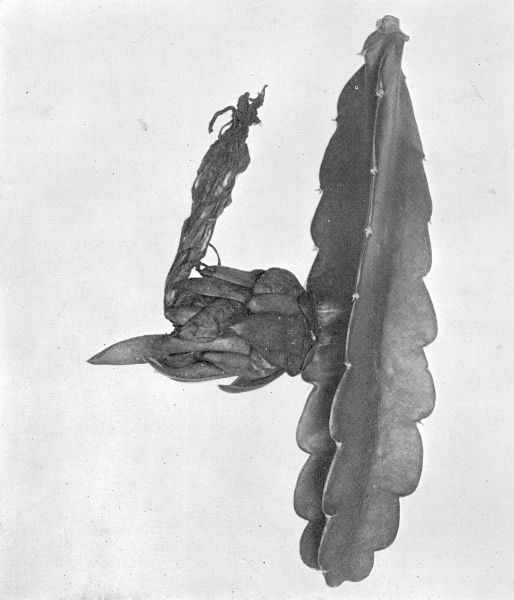
Plate CVIII.—Night-blooming Cereus.
Two thirds natural size.
Two thirds natural size.
[Pg 222]
Kigelia pinnata.
This medium-sized and very handsome shade tree is a native of tropical Africa. It was probably introduced to Hawaii by Dr. Hillebrand. A fine tree of this species is growing in Mrs. Foster's garden, Nuuanu avenue. It has large pinnate leaves, and panicles of purple flowers. The peculiar rough, grey, oblong fruits hang from a long stem, and present an odd appearance. This tree and also one other of the same variety growing in the grounds of the Queen's Hospital, very rarely set their fruit. Because of the difficulty of obtaining seeds, the sausage tree has not been widely distributed.
[Pg 223]
G. P. W. Collection. Plate CIX
Kigelia pinnata.
SAUSAGE TREE.
This medium-sized and very handsome shade tree is a native of tropical Africa. It was probably introduced to Hawaii by Dr. Hillebrand. A fine tree of this species is growing in Mrs. Foster's garden, Nuuanu avenue. It has large pinnate leaves, and panicles of purple flowers. The peculiar rough, grey, oblong fruits hang from a long stem, and present an odd appearance. This tree and also one other of the same variety growing in the grounds of the Queen's Hospital, very rarely set their fruit. Because of the difficulty of obtaining seeds, the sausage tree has not been widely distributed.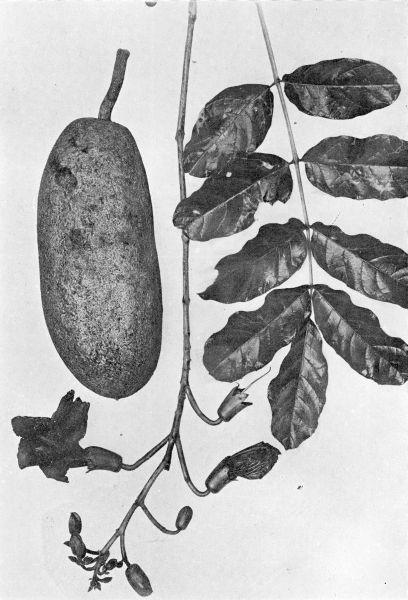
Plate CIX.—Sausage Tree.
One fourth natural size.
One fourth natural size.
[Pg 224]
Phoenix dactylifera.
The date, which is a native of North Africa, Arabia, and Persia, is a noble palm, often growing to a height of from 80 to 100 feet. It is of remarkable longevity, and will continue to produce fruit even at the age of a hundred years. The neighborhood of the sea is considered unfavorable to their production, although they will luxuriate in saltish soil and bear well when brackish water is used.
Many varieties of dates exist, the fruit differing in shape, size and color. They will grow from seeds, although the superior varieties can be continued only from off-shoots of the root. These will commence to bear in five years. In Asia, the growers of the commercial date find it necessary to pollinate artificially by hanging sprays of the male flowers in the branches of the fruit-bearing trees. There are no imported trees bearing in Hawaii, and although there are many date trees in Honolulu, artificial pollination would doubtless greatly increase the yield and the quality of the fruit.
[Pg 225]
G. P. W. Collection. Plate CX
Phoenix dactylifera.
THE DATE PALM.
The date, which is a native of North Africa, Arabia, and Persia, is a noble palm, often growing to a height of from 80 to 100 feet. It is of remarkable longevity, and will continue to produce fruit even at the age of a hundred years. The neighborhood of the sea is considered unfavorable to their production, although they will luxuriate in saltish soil and bear well when brackish water is used.Many varieties of dates exist, the fruit differing in shape, size and color. They will grow from seeds, although the superior varieties can be continued only from off-shoots of the root. These will commence to bear in five years. In Asia, the growers of the commercial date find it necessary to pollinate artificially by hanging sprays of the male flowers in the branches of the fruit-bearing trees. There are no imported trees bearing in Hawaii, and although there are many date trees in Honolulu, artificial pollination would doubtless greatly increase the yield and the quality of the fruit.
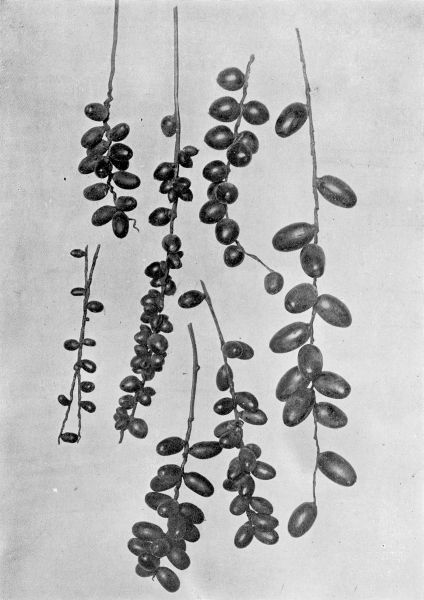
Plate CX.—The Date Palm.
One half natural size.
One half natural size.
[Pg 226]
Phoenix dactylifera.
The accompanying cut shows fruit from two of the best date trees in Honolulu, and it is curious to note that both of them were grown from seeds taken from packages of dried dates purchased from a local grocer.
[Pg 227]
G. P. W. Collection. Plate CXI
Phoenix dactylifera.
DATE (red and yellow variety).
The accompanying cut shows fruit from two of the best date trees in Honolulu, and it is curious to note that both of them were grown from seeds taken from packages of dried dates purchased from a local grocer.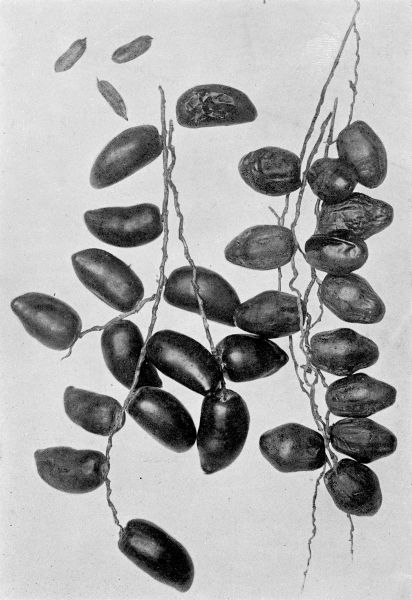
Plate CXI.—Date (red and yellow var.)
One third natural size.
One third natural size.
[Pg 228]
The inflorescence is simple and branching. The fruit is arranged similar to that of Cocos, each about three-fourths of an inch in diameter, sub-globose with a pointed apex. When ripe, it is a bright yellow, and its juicy, edible pulp has the flavor of apricots.
[Pg 229]
G. P. W. Collection. Plate CXII
Acrocomia sp.
This interesting palm is seldom seen in Hawaii; there being but two specimens of its kind that have produced fruit in Honolulu. Its stem is capitately thickened at the persistent bases of the armed petioles. The glaucous leaves are pari-pinnate with narrow, lanceolate, accuminate segments, having a prominent mid-rib.The inflorescence is simple and branching. The fruit is arranged similar to that of Cocos, each about three-fourths of an inch in diameter, sub-globose with a pointed apex. When ripe, it is a bright yellow, and its juicy, edible pulp has the flavor of apricots.
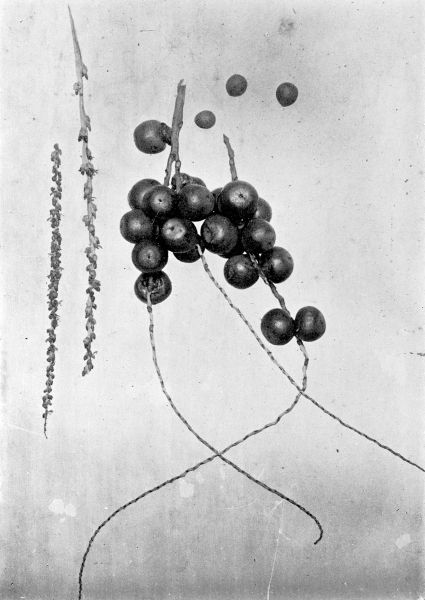
Plate CXII.—Acrocomia sp.
One half natural size.
One half natural size.
[Pg 230]
Cocos nucifera.
The original home of this widely-diffused tree is not positively known. Some writers say it is indigenous to the islands of the Indian Ocean; others show that in all probability it is of American origin. On account of its buoyant husk and impervious shell, it was enabled to drift across the oceans without losing its germinating power, and in this manner was widely dispersed. It is strictly a tropical plant, and grows naturally on the seashore, or in its immediate vicinity.
It has pinnate leaves about 12 to 18 feet long, and the inflorescence first appears in a cylindrical sheath, which splits length-wise, exposing long sprays of male flowers, and near the base generally one female flower, which is much larger, and eventually develops into a fruit. The picture shows both forms of flowers, as well as a young nut, and also a mature cocoanut. Propagation is by means of the nut alone, which must be thoroughly ripe before planting. The outer husk must be left on, germination taking place at the largest eye; sometimes two eyes may sprout, and twin trees grow from these. Many varieties have been imported from islands of the Pacific, Ceylon, West Indies, and Central America. The cocoanut is not raised in Hawaii for commercial purposes.
[Pg 231]
G. P. W. Collection. Plate CXIII
Cocos nucifera.
COCOANUT PALM.
"NIU."
The original home of this widely-diffused tree is not positively known. Some writers say it is indigenous to the islands of the Indian Ocean; others show that in all probability it is of American origin. On account of its buoyant husk and impervious shell, it was enabled to drift across the oceans without losing its germinating power, and in this manner was widely dispersed. It is strictly a tropical plant, and grows naturally on the seashore, or in its immediate vicinity.It has pinnate leaves about 12 to 18 feet long, and the inflorescence first appears in a cylindrical sheath, which splits length-wise, exposing long sprays of male flowers, and near the base generally one female flower, which is much larger, and eventually develops into a fruit. The picture shows both forms of flowers, as well as a young nut, and also a mature cocoanut. Propagation is by means of the nut alone, which must be thoroughly ripe before planting. The outer husk must be left on, germination taking place at the largest eye; sometimes two eyes may sprout, and twin trees grow from these. Many varieties have been imported from islands of the Pacific, Ceylon, West Indies, and Central America. The cocoanut is not raised in Hawaii for commercial purposes.
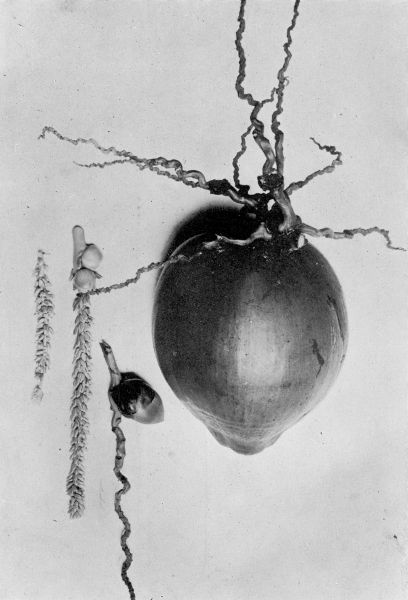
Plate CXIII.—Cocoanut Palm—"Niu."
One half natural size.
One half natural size.
[Pg 232]
Cordia collococca.
This low tree, with its spreading branches, is a native of the West Indies, and is rarely met with in these Islands; there being but two trees of its kind known to me, one growing at the Old Plantation, Honolulu, the other at Honouliuli Ranch, Oahu. The whitish branches are very brittle. The leaves are obovate, oblong, glabrous above and shiny beneath. The subsessile flowers are whiteish-purple. The fruit, which is half inch in diameter, is bluntly pointed and smooth. The fleshy pulp is sticky, and adheres to the single seed. This plant may be grown from seeds and from cuttings.
[Pg 233]
G. P. W. Collection. Plate CXIV
Cordia collococca.
CLAMMY CHERRY.
This low tree, with its spreading branches, is a native of the West Indies, and is rarely met with in these Islands; there being but two trees of its kind known to me, one growing at the Old Plantation, Honolulu, the other at Honouliuli Ranch, Oahu. The whitish branches are very brittle. The leaves are obovate, oblong, glabrous above and shiny beneath. The subsessile flowers are whiteish-purple. The fruit, which is half inch in diameter, is bluntly pointed and smooth. The fleshy pulp is sticky, and adheres to the single seed. This plant may be grown from seeds and from cuttings.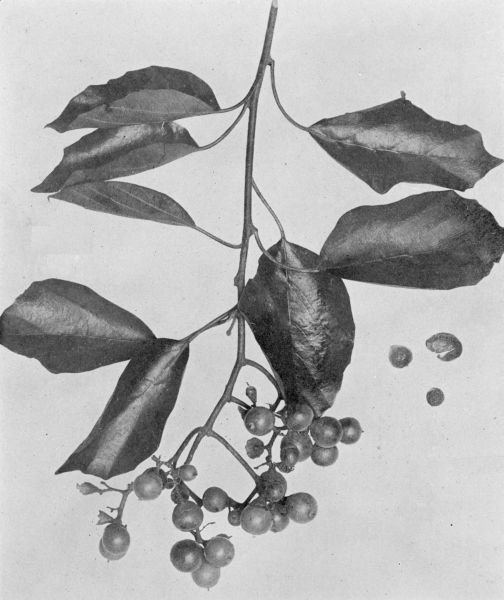
Plate CXIV.—Clammy Cherry.
One half natural size.
One half natural size.
[Pg 234]
[Pg 235]
G. P. W. Collection. Plate CXV
Flacourtia cataphracta.
This tree, which is a native of the Malay Islands and China, was introduced to Hawaii by Mr. Albert Jaeger. There is but one tree which has borne fruit; this is growing at the Old Plantation, Honolulu, Oahu. The tree, which is about 25 feet high, has dense foliage; the leaves are small, oblong, lanceolate, glabrous, having short petioles. Flowers very small, dioceous; the fruit about the size of a common grape, is purple when ripe, and has a pleasant sub-acid flavor. It contains a few flatish seeds.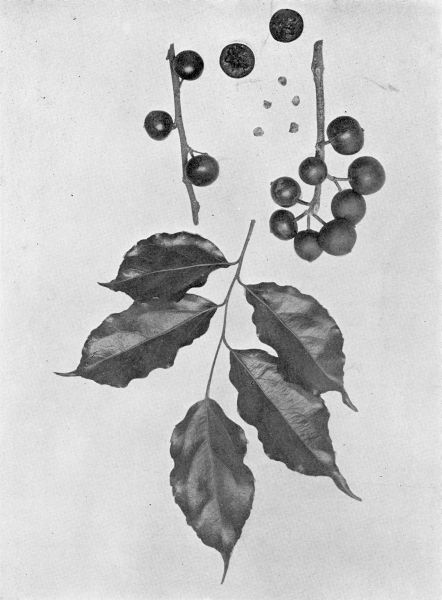
Plate CXV.—Flacourtia cataphracta.
One half natural size.
One half natural size.
[Pg 236]
[Pg 237]
G. P. W. Collection. Plate CXVI
Atalantia buxifolia.
This small tree of dwarfish habit is from tropical Asia. It is closely related to the orange, and has large thorns. Its simple leaves are alternate, coriaceous, emarginate, and from 1 to 1½ inches in length. The petioles are short. The small, solitary flowers have five petals. The berry is globose and three-quarters of an inch in diameter. When ripe, it is a shiny black, and has a thick skin. The pulp has somewhat the flavor of a lime, and the seeds are generally 1 to 5 in number. The only specimens of this tree in Hawaii are growing in the garden of Mrs. Foster; they, presumably, were introduced by Dr. Hillebrand, as these gardens formerly belonged to him.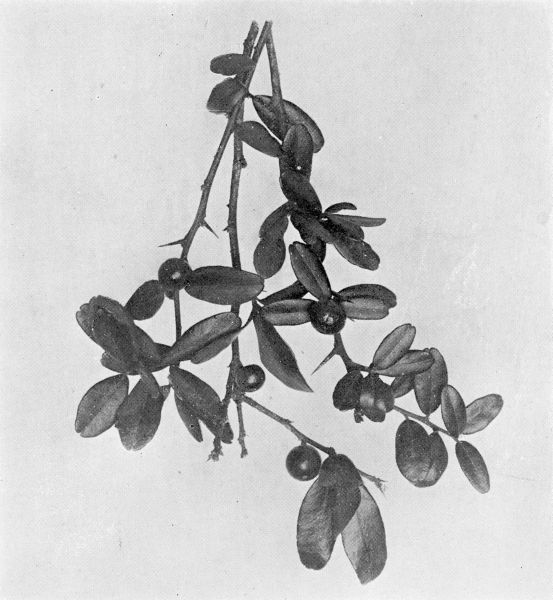
Plate CXVI.—Atalantia buxifolia.
One half natural size.
One half natural size.
[Pg 238]
[Pg 239]
G. P. W. Collection. Plate CXVII
Bumelia sp.
This large shrub is a native of India. Its alternate, entire, obovate leaves have short petioles; they are glabrous and are about 4 to 8 inches in length. The small flowers are light pink. The small, globose fruits grow in bunches; these are purple when ripe, but are not edible. The only tree of its kind in Honolulu is growing in the grounds of the Queen's Hospital.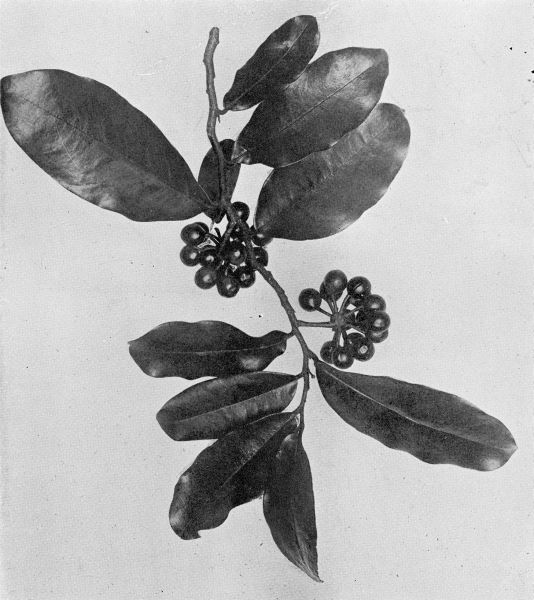
Plate CXVII.—Bumelia sp.
Natural size.
Natural size.
[Pg 240]
[Pg 241]
G. P. W. Collection. Plate CXVIII
Ochrosia elliptica.
This plant grows in the Pacific Islands, Malay Peninsula, Ceylon, and Australia; and on account of its handsome scarlet fruit is cultivated as an ornament, as the fruit is not edible. The tree is a small evergreen, having alternate, glabrous, coriaceous leaves which are crowded at the ends of the stout branches. The small, white flowers have five petals. The fruit consists usually of two, rarely one, spreading scarlet drupes, each containing a large seed. The first specimen of its kind in Hawaii was planted at the Government Nursery, Honolulu, where it is still growing.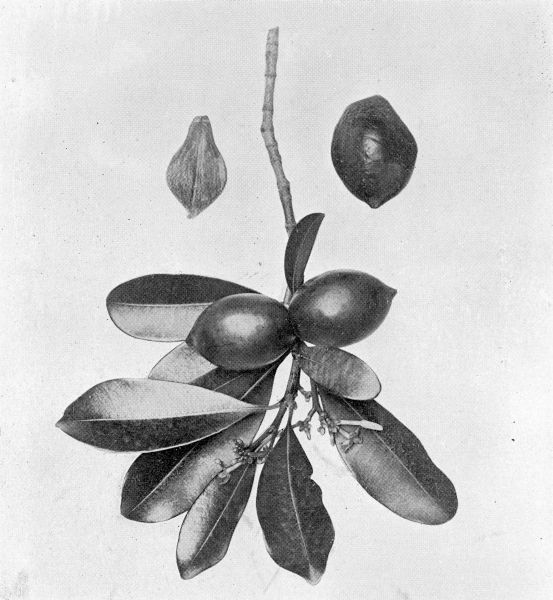
Plate CXVIII.—Ochrosia elliptica.
One half natural size.
One half natural size.
[Pg 242]
Ananas sativus.
This variety of the pineapple plant was grown at an early date in these Islands, and until the new and spineless forms were introduced was the only quality offered in the fruit markets. It is now cultivated but little, and is often found growing wild. The rosette at the head of the fleshy fruit has numerous thorny leaves. The fruit is much smaller than those of the thornless varieties, but it has a very sweet flavor.
[Pg 243]
G. P. W. Collection. Plate CXIX
Ananas sativus.
PINEAPPLE.
This variety of the pineapple plant was grown at an early date in these Islands, and until the new and spineless forms were introduced was the only quality offered in the fruit markets. It is now cultivated but little, and is often found growing wild. The rosette at the head of the fleshy fruit has numerous thorny leaves. The fruit is much smaller than those of the thornless varieties, but it has a very sweet flavor.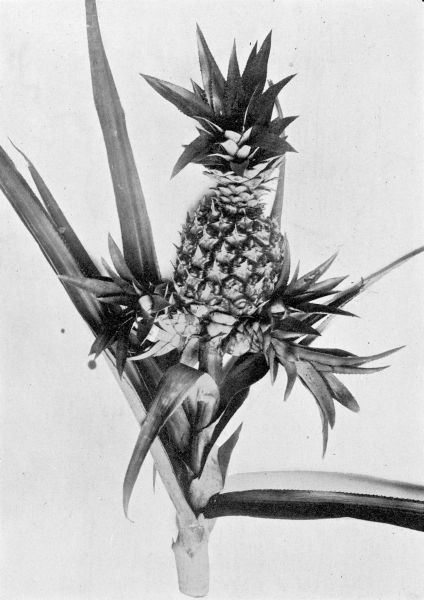
Plate CXIX.—Pineapple.
One half natural size.
One half natural size.
[Pg 244]
Opuntia Tuna.
This erect, wide-spreading plant was early introduced to these Islands from Mexico. It thrives well in arid lands, and in times of drought its succulent, fleshy leaves and juicy fruit are eaten by cattle. The plants, when old, become hard and woody, having many stout spines. The large flowers are reddish-yellow, and the obovate, truncate fruit is a purplish-red, having a thick fibrous skin, which is covered with fine bristles. The edible pulp is reddish-purple and contains numerous seeds.
[Pg 245]
G. P. W. Collection. Plate CXX
Opuntia Tuna.
PRICKLY PEAR—"PANINI."
This erect, wide-spreading plant was early introduced to these Islands from Mexico. It thrives well in arid lands, and in times of drought its succulent, fleshy leaves and juicy fruit are eaten by cattle. The plants, when old, become hard and woody, having many stout spines. The large flowers are reddish-yellow, and the obovate, truncate fruit is a purplish-red, having a thick fibrous skin, which is covered with fine bristles. The edible pulp is reddish-purple and contains numerous seeds.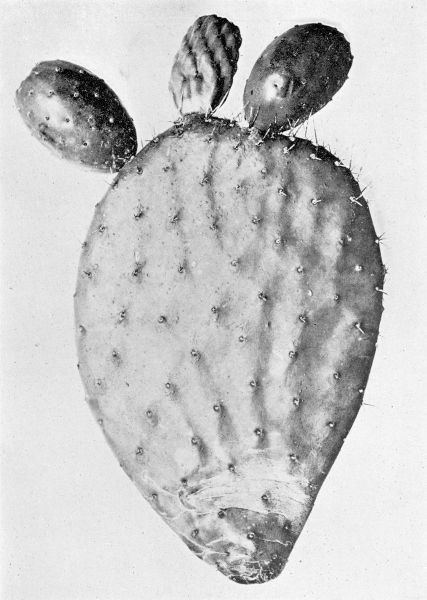
Plate CXX.—Prickly Pear—"Panini."
One half natural size.
One half natural size.
[Pg 246]
Prosopis juliflora.
The Kiawe deserves a special mention in this book, as it is, in my opinion, one of the most valuable and beautiful trees that grows in the Hawaiian Islands. Perhaps on account of its very general dissemination, and because of the ease with which it spreads spontaneously, even in the driest districts, it has received less consideration than has been accorded to other plants more difficult of propagation.
The Kiawe is the foundation of all the beauty of our lowlands, and provides a delicate background for other plants. Under favorable circumstances, it reaches to a height of 50 feet. It has wide-spreading branches and delicate-green foliage. The flowers yield a delicious honey, and the seed-pods furnish a valuable fodder, and, finally, when the tree is cut down, its wood makes the very best of fuel. The Algaroba is a native of Central and South America. Ordinarily it is a moderate-sized tree of quick and easy growth. Its branches in most cases are covered with stout, cylindrical, axillary spines, and in other cases they are unarmed.
The abruptly bi-pinnate leaves have from 6 to 30 pairs of linear leaflets about one-fourth to one inch in length. The small, pale-yellow flowers come in cylindrical spikes. The straight or sickle-shaped seed-pod is sweet, and is eaten by stock. Propagation is by seed.
The first Algaroba tree of Hawaii was brought to Honolulu in 1828 by Father Bachelot, founder of the Roman Catholic Mission in the Islands. It was planted in the Mission garden, where the venerable tree is standing today.
[Pg 247]
G. P. W. Collection. Plate CXXI
Prosopis juliflora.
ALGAROBA—"KIAWE."
The Kiawe deserves a special mention in this book, as it is, in my opinion, one of the most valuable and beautiful trees that grows in the Hawaiian Islands. Perhaps on account of its very general dissemination, and because of the ease with which it spreads spontaneously, even in the driest districts, it has received less consideration than has been accorded to other plants more difficult of propagation.The Kiawe is the foundation of all the beauty of our lowlands, and provides a delicate background for other plants. Under favorable circumstances, it reaches to a height of 50 feet. It has wide-spreading branches and delicate-green foliage. The flowers yield a delicious honey, and the seed-pods furnish a valuable fodder, and, finally, when the tree is cut down, its wood makes the very best of fuel. The Algaroba is a native of Central and South America. Ordinarily it is a moderate-sized tree of quick and easy growth. Its branches in most cases are covered with stout, cylindrical, axillary spines, and in other cases they are unarmed.
The abruptly bi-pinnate leaves have from 6 to 30 pairs of linear leaflets about one-fourth to one inch in length. The small, pale-yellow flowers come in cylindrical spikes. The straight or sickle-shaped seed-pod is sweet, and is eaten by stock. Propagation is by seed.
The first Algaroba tree of Hawaii was brought to Honolulu in 1828 by Father Bachelot, founder of the Roman Catholic Mission in the Islands. It was planted in the Mission garden, where the venerable tree is standing today.
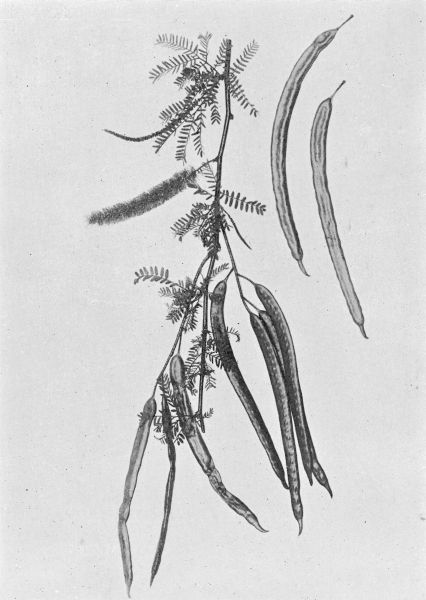
Plate CXXI.—Algaroba—"Kiawe."
Detailed Transcriber's Notes
General Notes.
The relative size of items noted in the captions of the Plates relates to the original book, not to this document. Scaling of the images in preparation of this ebook and the size and resolution of the media on which the ebook is read make general statements about relative size of the pictured items impossible.The "Index" was completely reworked so that it reflects the titles and captions within the body of the book. The original style was maintained. Details of changes to the "Index" are omitted. Links in the "Index" point to the text preceding a Plate, not the Plate itself, whereas the page number indicates the Plate.
When opening the original book to any of the Plate pages, the associated text appeared on the left hand page and the Plate appeared on the right hand page. Therefore, in this ebook, the text associated with a Plate always precedes the Plate.
The text of the book varies from the original in that obvious misprints have been fixed. Where the intent of the misprint was not obvious, it has been left in place and noted below. Use of archaic and unusual words, spelling and styling has been maintained. Inconsistent hyphenation has been retained. Capitalization of botanical names is maintained as in the original. Details of the changes follow.
Details of the changes.
Frequently used archaic spellings and styling which have been maintained: anona (annona), cocoanut (coconut), Guatamala (Guatemala), and Nuuanu avenue (Nuuanu Avenue). Others occur less frequently.Both the spellings preceding and preceeding were used throughout the book. They have been standardized to preceding, as noted below.
In the caption of Plate III, to match the text title—changed to: Guatamala Avocado (in original book: Avocado).
In the text with Plate IV, changed to: elevation (in original book: elevtaion); and inserted period after the fruit-bearing stems.
In the text with Plate V, changed to: successful (in original book: ssuccessful).
In the text with Plate XI, changed to: preceding (in original book: preceeding).
In the text with Plate XVII, changed to: soil (in original book: sosil); and to: preceding (in original book: preceeding).
In the text title with Plate XX, changed to: edulis (in original book: eduiis).
In the text with Plate XXII, for clarity, changed to: 1-16th (in original book: 1-16); and changed to: underside (in original book: under-side) for consistency with elsewhere in the book.
In the text with Plate XXIV, changed to: small (in original book: samll).
In the text with Plate XXXI, changed to: leaves (in original book: laves) and changed to: who (in original book: whos).
In the text and captions associated with Plates XXXV, XXXVI and XXXVII, the spellings papaya and papaia were both used. They have been standardized to papaya.
In the caption of Plate XXXVI, moved the period (".") outside the parentheses, to match chapter heading.
the text with Plate XXXVII, the word pesin is probably a printing error, however it is unclear whether the intended word was resin or pepsin. The error has been left as in the original.
In the text with Plate XXXVIII, changed to: generally (in original book: generaly).
In the caption of Plate XXXVIII, italicized Chinese Orange for consistency with other caption formatting.
In the text title and caption of Plate XLI, changed to: lime (in original book: limes) for consistency with rest of the book.
In the title of the text with Plate XLV, changed to: WASHINGTON NAVEL ORANGE (in original book: WASHINGTON NAVEL).
In the text with Plate LVI, changed to: protuberance (in original book: portuberance).
In the text title and caption of Plate LVIII, changed to: Sweet Red Guava (in original book: Sweet red).
In the text with Plate LVIII, changed to: preceding (in original book: preceeding).
In the title of the text with Plate LXIV, changed to: LXIV (in original book: LXVI).
In the text with Plate LXVI, changed to: following (in original book: folowing); and changed to: so-called (in original book: socalled) for consistency with elsewhere in the book.
In the title of the text with Plate LXVII, changed to: varieties (in original book: varities); and in the text, changed to: center (in original book: centre) for consistency with the elsewhere in the book.
In the text with Plate LXX, I suspect that 100 to 40 should have been 10 to 40.
In the text and caption of Plate LXXII, changed to: candlenut (in original book: candle nut, candle-nut and candlenut) for consistency within this page.
In the text with Plate LXXIX, changed to: preceding (in original book: preceeding).
In the text with Plate LXXXVI, changed to: consists (in original book: consistss).
In the text with Plate LXXXIX, changed to: parabola (in original book: parobola).
In the text with Plate XCI, changed to: yellow (in original book: yelow).
In the text with Plate XCV, changed to: delicious (in original book: declicious).
In the title of the text with Plate XCIX, changed to: Phyllanthus (in original book: Phllanthus).
In the title of the text with Plate CII, changed to: Sinensis (in original book: Sinense).
In the title of the text with Plate CIII and in the caption: Granadilla (in original book: Grenadilla).
In the text with Plate CIII, changed to: climber (in original book: climer); and changed to: succulent (in original book: suculent).
In the caption of Plate CVIII, changed to: Night-blooming (in original book: Night-Blooming) for consistency in caption formatting.
In the text with Plate CX, changed to: considered (in original book: considereed); and changed to the archaic word: saltish (in original book: satlish).
In the text with Plate CXIII, changed to: American (in original book: Ameriican).
In the title of the text with Plate CXIV, changed to: collococca (in original book: colloccoca).
In the text with Plate CXVII, changed to: Honolulu (in original book: Honolulue).
In the text with Plate CXVIII, changed to: where it is (in original book: where is is).
In the caption of Plate CXIX, for consistency changed to: Pineapple (in original book: Pine apple).
No comments:
Post a Comment